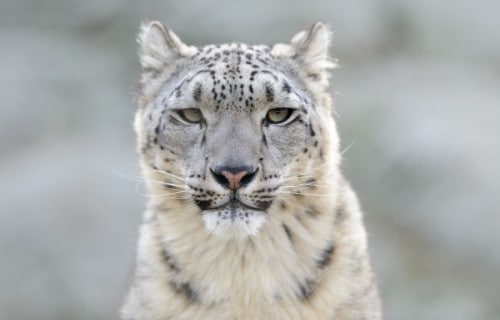
Wonderful Wild Cats of the World
We hope that each of you, our readers, will enjoy and appreciate this article we present about these Wonderful Wild Cats of the World. It was certainly our pleasure to gather the information for you. May it provide you with both education and increased awareness.
Certainly, these few species listed herein represent only a portion of the similar species found across the globe. It’s our belief, though, that they serve as excellent representations of the wonders found here. Check out some of our other articles for similar marvels.
Iberian Lynx
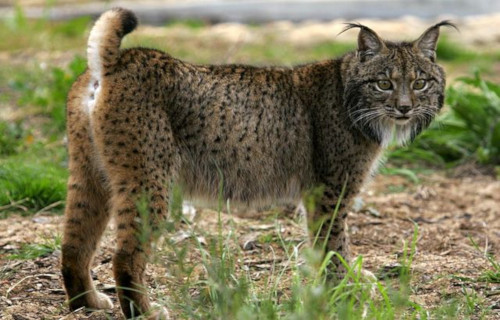
Iberian Lynx Facts
- The first of our Wonderful Wild Cats of the World is the Iberian Lynx. It is a species of wildcat currently only found in a small section of western Europe.
- This infromative term serves as the name of the small mammal that represents a beautiful species of wildcat. Its habitat range gives it an unfortunate status. The IUCN presently lists this beautiful animal as Endangered, on its published Red List.
- Currently, the primary threats to its continued existence include such factors as habitat loss and a significant reduction of its natural prey. Most regretaably, the gorgeous mammal now faces a somewhat unique threat to its continued existence.
- This occurs due to the fact that two separate diseases have significantly reduced the amount of available prey for the gorgeous wild feline. Concerted efforts by associations such as the EU LIFE-Nature project, however, do currently remain underway.
- For the moment, these ongoing rescue efforts include captive breeding and reintroduction programs. Partly due to these awesome efforts, the known population numbers of the beautiful Iberian Lynx in the wild appear to be on the rise.
- But quite lamentably, that known population still remains at only 309 individuals. This still leaves it highly vulnerable to its many threats. That’s worse, since it also now faces the threat of climate change, much like many other species around the world.
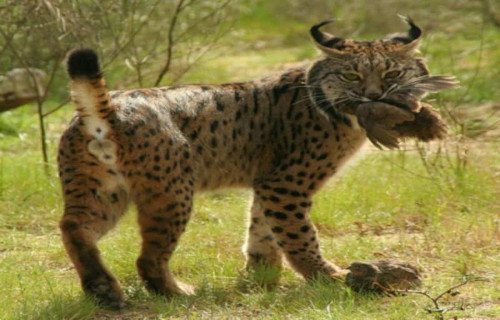
Iberian Lynx Physical Description
With its wondrous appearance, the Iberian Lynx attains an average head and body length of roughly 43 in (110 cm). The tail stays relatively short in comparison with other species of wildcat. Individuals also average about 12 in (30 cm) in length.
This particular variety of lynx also displays a moderate degree of the characteristic of sexual dimorphism, much like many of the related species. Though the lengths remain similar between the genders, the male develops significantly stockier in its build.
The male additionally averages nearly 28 lb (13 kg). The female of the species, though, averages around 21 lb (9.4 kg) in weight. The legs of the Iberian Lynx grow relatively long. Like other species of lynx, the ears on this impressive have a prominent tuft.
This Iberian Lynx also presents a magnificent color scheme, making it impossible to confuse with others. The coloring generally appears tawny, with dark spots of varying sizes. The muzzles appear slightly more elongated in shape than most varieties of wildcats.
- Kingdom: Animalia
- Phylum: Chordata
- Class: Mammalia
- Order: Carnivora
- Family: Felidae
- Genus: Otocolobus
- Species: O. manul
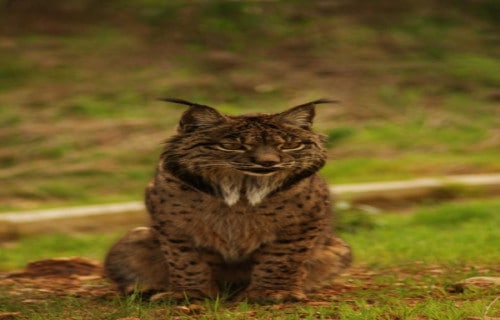
CCL: http://bit.ly/2zQZYSZ
Iberian Lynx Distribution and Habitat
Fossil evidence also indicates that the Iberian Lynx has never had a significant endemic range. Luckily, that range remains sufficient for it. It once inhabited a range that encompassed a region that included portions of what is now France, Portugal, and Spain.
Currently, the remarkable mamma is only known to exist in two areas in Andalucia, Spain. Only two known breeding populations remain. Much of what previously constituted its natural habitat range has now been taken for the construction of roads and dams.
The Iberian Lynx has decided habitat preferences. It generally prefers to inhabit regions of open grassland mixed with areas of dense shrubbery. Presently, its known population is restricted to areas of maquis shrubland, lowland forests, and mountain areas.
Florida Panther
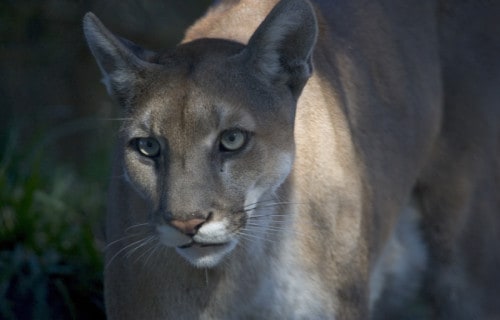
Florida Panther Facts
- Next up in this article about the many Wonderful Wild Cats of the World comes the magnificent feline that is the Florida Panther.
- This majestic product of Nature and evolution most commonly goes by the informative common name for good reasons. It also has other general names, though. These include such terms as Florida cougar, Florida Puma, and Coast Rican puma.
- Among scientific professionals, however, it’s better known by its formal moniker. That’s the somewhat different term of Puma concolor cougar. Regardless of the title one chooses to use, it represents a severely threatened subspecies of cougar.
- It received that unique technical name due to the efforts of the American zoologist, Outram Bangs. This researcher accomplished the first known acknowledgement of it as a separate and distinct species. That scientifically noteworthy action occurred in 1899.
- The mammal also represents the only subspecies of cougar in its part of the country it lives in. To the knowledge of wildlife experts, it only occupies about 5% of its former range. Current estimates place its total population at just over 200 individuals.
- Given this sad situation, the IUCN now lists the animal as Critically Endangered. That status is reflected on the organization’s published Red List of Threatened Species. Before protections existed, its numbers once dwindled to only 20 specimens.
- Because of its scant numbers and restricted range, it understandably faces many threats to its existence. Further habitat loss due to human expansion obviously qualifies. Like most species on earth, though, it also now faces the perils of climate change.
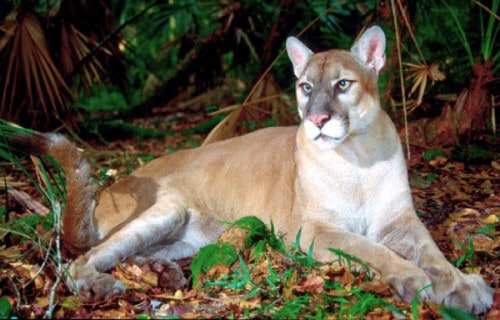
Florida Panther Physical Description
The magnificent Florida Panther immediately impresses anyone fortunate enough to view one. Much like its close relatives, it does so due to a combination of factors. One’s its sheer size. Though certainly not as large as some wild felines, it’s nonetheless respectable.
Also following a pattern common to its kin, the animal shows a moderate degree of the physiological trait of sexual dimorphism. In its specific case, though, this trait manifests itself purely in terms of size. In overall appearance, however, the genders appear the same.
Regarding the sheer physical size, though, males most often attain larger growth than their female counterparts. These reach weights equaling up to a respectable 159 lb (72 kg). They also attain a known head-to-tail length that ranges from 5.9 – 7.2 ft (1.8 – 2.2 m).
Females, meanwhile, generally reach moderately shorter lengths. They also develop a somewhat more slendere body shape. This further reduces their mass in comparison with males. Females therefore reach a weight that ranges from between 64 – 100 lb (29 – 45.5 kg).
Otherwise, the sexes of the Florida Panther remain virtually indistinguishable based on patterns of color. At birth, both present a spotted pattern, and striking blue eyes. As they mature, though, the eyes change to a yellowish shade, while the spots disappear entirely.
Among mature adult specimens of the animal, the fur of the upper body takes on a deep tan hue. The underbelly of the gorgeou mammal, though, usually shows a creamy white in color. In contrast, distinctive black markings manifest on the tips of the tail and ears.
- Kingdom: Animalia
- Phylum: Chordata
- Class: Mammalia
- Order: Carnivora
- Family: Felidae
- Genus: Puma
- Species: P. concolor
- Subspecies: P. c. couguar

Florida Panther Distribution, Habitat, and Ecology
The native range of the Florida Panther probably comes as no surprise. That’s due to the simple fact that its very name provides a clear indication of that territory. As that dictates, the animal evolved as native to the state of Florida, in the United States, in North America.
Yet even there, as mentioned previously, it only inhabits a portion of its former range. That consists of the southeastern portion of the state. Records indicate that it once appeared in either all or at least parts of at least 6 other states. It’s unknown if it ever lived beyond that.
This marvel of Nature is highly adapted to its habitat. Unfortunately, though renders it vulnerable in many ways. Its highly limited range now severely limits the simple number of locations it can potentially appear. All of these occur in the southeast portion of Florida.
There, the majestic creature lives almost exclusively in one of three types of ecosystems. These consist of regions of tropical hardwood hammocks, pinelands, or mixed freshwater swamp forests. Luckily, much of its remaining range now lies within protected areas.
Again following a pattern common to wild felines, each individual Florida Panther migrates through its territory. This mainly occurs during the day. Most specimens prefer to spend their days in the wetlands, then move to grassland in the evening. It’s also mainly nocturnal.
Given its feline ancestry, it naturally evolved as carnivorous in nature. Its prey typically consists of a variety of small animals. It will, however, attack larger prey. These typically include such species as deer or wild boar. Alligators comprise its only known natural predator.
Marbled Cat
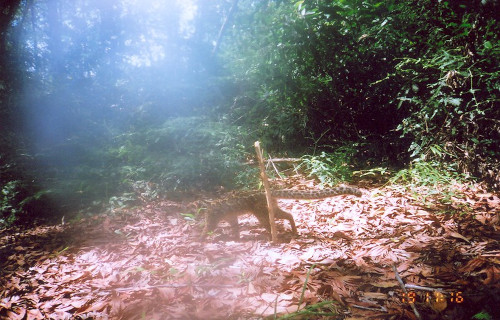
Marbled Cat Facts
- The Marbled Cat is another of the Wonderful Wild Cats of the World. It’s also an extremely reclusive species of small wild cat endemic to a severely restricted range.
- This beautiful creation of Nature and evolution most frequently goes by the descriptive common name for obvious reasons. Somewhat uncommonly, that’s presently the only globally used general moniker for this intriguing species of wild feline.
- Within scientific circles, however, it’s better known by its technical title. Like many such, though, it’s a relatively difficult name for the layperson to pronounce. That’s because the small yet amazing mammal bears the formal title of Pardofelis marmorata.
- It received that slightly tongue-twisting honorifc due to the efforts of the respected English naturalist, William Charles Linnaeus Martin. He accomplished the first recorded acknowledgement of the creature as a separate and distinct species in 1836.
- It’s actually closely related to two other equally remarkable wild felines. These close genetic cousins hold the names of the Borneo Bay Cat and the Asian Golden Cat. Each of these three diverged from shared ancestors approximately 9.4 million years ago.
- While not ideal, its current population and range appear to be relatively stable. This fortunate situation also seems to hold true throughout the entirety of that territory. The IUCN, therefore. presently lists the animal as Near Threatened on its Red List.
- Sadly, the fabulous Marbled Cat nevertheless faces many ongoing threats to its continued existence. Deforestation continues to form an ever-present danger to the species. Now, however, it faces the perils posed by climate change, like most species.
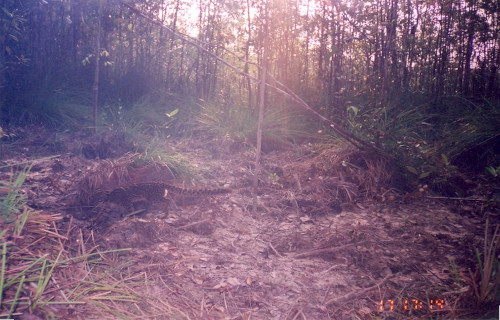
Marbled Cat Physical Description
The stunning Marbled Cat quickly captivates and amazes those fortunate enough to encounter one in the wild. The carnivore typically does so due more to its appearance, though, than its physical measurements. That’s because it’s smaller than many relatives.
This tendency further holds true for individuals of both genders. Many species display varying degrees of the physiological characteristic of sexual dimorphism. Specimens of this distinctily evolved feline, however, displays no outwardly noticeable degree of that trait.
In terms of general size, it’s been compared to a common domestic house cat. That’s with one exception, however. That has to do with the tail of the beautiful wild cat. In this specific species, that appendage grows much bushier, and may be longer than the body.
Individuals of both sexes attain a head and body length that averages between 18 – 24 in (45.7 – 61 cm). The tail itself, meanwhile, varies significantly in length between cats. This bushy appendage grows to a length that averages from 14 – 22 in (35.6 – 55.9 cm).
This species’s weight also varies widely among mature examples of the Marbled Cat. That occurs due to various factors, including, of course, availability of prey in different ranges. Overall, though, this measurement ranges from about 4.4 – 11.0 lbs (2 – 5 kg).
It’s its general appearance, however, that understandably garners the most attention. The coat develops as thick and soft. This additionally varies ini background from dark grayish-brown, through yellowish-brown to reddish-brown. Black stripes also form on the head.
- Kingdom: Animalia
- Phylum: Chordata
- Class: Mammalia
- Order: Carnivora
- Family: Felidae
- Genus: Pardofelis
- Species: P. marmorata

Marbled Cat Distribution, Habitat, and Ecology
The masterpiece of evolution that’s the Marbled Cat evolved as native to a limited range of the globe. That’s most unfortunate, to be certain. Yet where that zone of habitation occurs probably won’t surprise many people. It’s native to a small part of Southeast Asia.
More precisely, it’s only known to live within specific sections of a few places. That’s the Himalayan foothills, India, Nepal, southwest China, and also the islands of Borneo and Sumatra. It’s currently unknown if the impressive feline ever lived in a greater area.
The extraordinary cat also evolved decided preferences for its choice of habitat. Due to that, the animal primarily chooses to make its home in regions of relatively dense forest. Even more specifically, these must be moist, and mixed evergreen-deciduous tropical.
Individuals do appear outside of such habitats on occasion, though. Some live in regions of bamboo forests and peat swamps. Impressively, it’s also adapted to high altitudes. A few observations place specimens at altitudes of as much as 12,500 ft (3,810 m).
Due to the reclusive nature of the Marbled Cat, we still know little about some aspects of this species.Nonetheless, a few facts have been learned about the elusive creature. Fo one, distinguishing itself form others in yet another way, it’s mainly arboreal.
Observations also indicate that the nature of this habitat serves a dual purpose. It likely provides it most of its prey. That’s believed to consist of such animals as squirrels, birds, reptiles, and rodents. Its own natural predators continue to remain unknown at this time.
Iriomote Cat
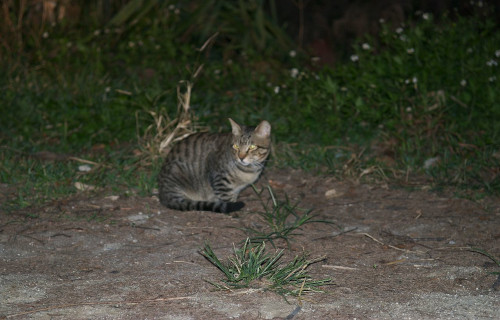
CCL: https://bit.ly/3lKKoSw
Iriomote Cat Facts
- The next entry into our list of Wonderful Wild Cats of the World is the stunning product of evolution known as the Iriomote Cat.
- This marvelous wild feline is most frequently referred to by the descriptive and informative common name used herein. That’s the english language name for it, though. In Japanese, it’s known by the very similar moniker of Iriomote-yamaneko.
- In scientific circles, however, it’s better known by its technical title. That term, though, is extremely hard for the layperson to pronounce. That’s because this beautiful creature bears the tongue-twisting formal title of Prionailurus bengalensis iriomotensis.
- The intriguing animal received that formal moniker due to the efforts of the Japanese zoologist, Yoshinori Imaizuni. He accomplished the first official recognition of the mammal as a specific subspecies of the much better known Leopard Cat.
- The population of the remarkable Iriomote Cat, already extremely small, seems to be falling rapidly. That unfortunate trend also appears to hold true throughout the entirety of its natural range. Recent estimates place its population at only 100 individuals.
- The IUCN thus now lists this incredible feline as Critically Endangered. That lamentable status is reflected on the organization’s published Red List of Threatened Species. Fears exist that the creature may soon disappear from the earth completely.
- It faces many threats in addition to its own limited numbers. Given its extremely limited natural range, habitat loss poses a proportionately higher danger than for some species. The animal also now faces the danger posed by ongoing climate change.
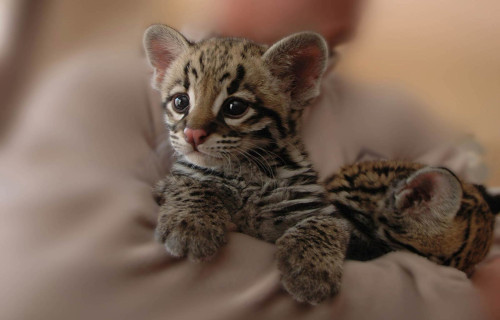
Iriomote Cat Physical Description
The beautiful Iriomote Cat certainly catches the eye of anyone fortunate enough to encounter one. It does so for several reasons, though. Its appearance is intriguing, since it looks much like a common house cat. But its sheer size remains slightly greater than these.
Much like most felines, though, it does display a certain degree of sexual dimorphism. In its case, this physiological characteristic manifests itself in terms of pure size. That’s true since males of the species attain slightly larger average phsyical measurements.
The males reach an average head-and-body length of approximately 22 – 24 in (55 – 60 cm). Their female counterparts, however, grow to an average of 20 – 22 in (50 – 55 cm). Among individuals of both genders, the tail attains a length from between 9.1 – 9.4 in (23 – 24 cm).
Weights also differ moderately accordingly between the two sexes. Being smaller, the females typically weigh between 6.6 – 7.7 lb (3 – 3.5 kg). The longer-bodied males, though, generally have a mass equaling 7.7 – 10.0 lb (3.5 – 5 kg). So there’s not a significant difference.
The overall body shape of the Iriomote Cat distnguishes it from most of its kin. It has a relatively long, thin body, with comparatively short, thick legs. The shoulders are powerful. It also presents a neck that’s thicker in relation to the rest of the body than most felines.
In appearance, most specimens present a predominantly light brown and dark gray combination. The stomach and underside of each limb, though, show a somewhat lighter shade. Two dark brown spots appear on each cheek, and 5-7 stripes running across the head.
- Kingdom: Animalia
- Phylum: Chordata
- Class: Mammalia
- Order: Carnivora
- Family: Felidae
- Genus: Prionailurus
- Species: P. bengalensis
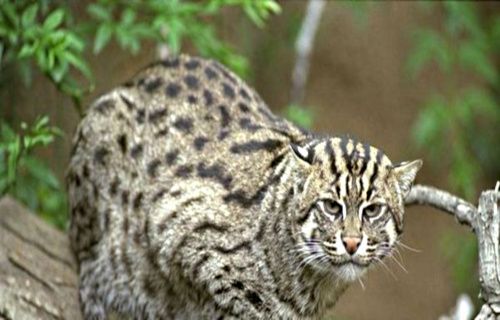
Iriomote Cat Distribution and Diet
Sadly, the delicate wonder of Nature that’s the Iriomote Cat has an extremely limited habitat range. In fact, that zone of habitation ranks as the smallest endemic area of habitation of any known wildcat. It might surprise some to learn that it’s native to Asia.
Even there, though, the animal only lives within a very tiny geographical area. That appears in a portion of the country of Japan. Yet even there, it lives solely on a single island. That’s the tiny island of Iriomote, measuring just 112 sq mi (290 sq km) in total area.
Further limiting its expanision opportunities is its very specific habitat requirement. The vast majority of known specimens live in one specific ecosystem. That consists of the regions of subtropical forests. That habitat does, at least, cover roughly 90% of the island.
Inside of that area, though, it also displays decided preferences for certain altitudes. The specifically evolved small mammal rarely appears at altitudes in excess of 656 ft (200 m) above sea level. The precise reason for this, however, still eludes its many researchers.
Unlike most related species, the Iriomote Cat appears to be a primarily terrestrial type of wildcat. It will, however, climb trees, and even swim when necessary. It also evolved as nocturnal in nature, with the primary period of activity being during the twilight period.
During the day, the wildcat prefers to remain in caves or hollow trees. As with most related species, it marks its territory. It’s also entirely carnivorous in its eating habits. That diet primarily consists of small varieties of birds, reptiles, fish, amphibians, and crustaceans.
Asian Golden Cat
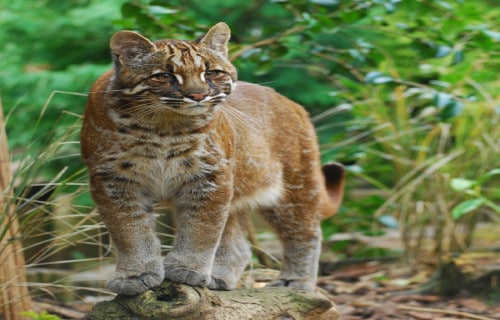
Asian Golden Cat Facts
- The Asian Golden Cat is yet another of our Wonderful Wild Cats of the World. It is a beautiful medium size species of wild cat native to a highly restricted habitat range.
- However, researchers have little data about the reproductive patterns or lifespan of this rather astonishing animal in the wild.
- Captive specimens average a 20-year lifespan. It would certainly be very sad to see this wonderful species in captivity.
- Also, the IUCN has categorized the cat as Near Threatened. The primary threat to this species is deforestation in its habitat zones which is, alas, a significant threat to many more species as well.

CCL: https://bit.ly/2XeVJ38
Asian Golden Cat Physical Description
The rather marvelous Asian Golden Cat evolved to be rather heavily built. It has an average body length of approximately 41 in (105 cm), and a tail averaging 22 in (56 cm).
The weight of the Asian Golden Cat ranges from 20-35 pounds (9-16 kg). No discernible sexual dimorphism exists in this species.
The cat’s coat also generally appears uniform in color, but the coloring ranges from red to golden brown, dark brown, cinnamon, gray or even occasionally black.
Black and white lines also typically run across the cheeks and to the top of the head, in a distinctive pattern of markings.
- Kingdom: Animalia
- Phylum: Chordata
- Class: Mammalia
- Order: Carnivora
- Family: Felidae
- Genus: Catopuma
- Species: C. temminckii
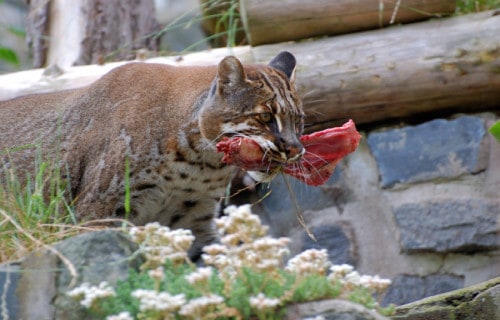
CCL: http://bit.ly/2P4R3Ic
Asian Golden Cat Distribution, Habitat, and Ecology
The habitat range of the cat includes select portions of southeast Asia. This includes Nepal, Tibet, Bhutan, India, Bangladesh, Thailand, Cambodia, Laos, Vietnam, Malaysia, Sumatra and parts of China.
Consequently, the animal generally prefers forest regions which are mixed with rocky areas, subtropical evergreen, and also tropical rainforests.
In the Himalayas, it can also live at altitudes of as much as 9,800 ft (3,000 m). In Laos, it has also adapted to life in the bamboo forests.
But by nature and just like many other felines, it remains a territorial and solitary animal. The species also evolved as primarily nocturnal, but will occasionally venture out during the day.
The felines prove to be rather crafty hunters and prey principally upon birds, large rodents, reptiles, and small deer.
The animal also remains far more powerful than it appears and is capable of bringing down prey several times its own size.
Scottish Wildcat
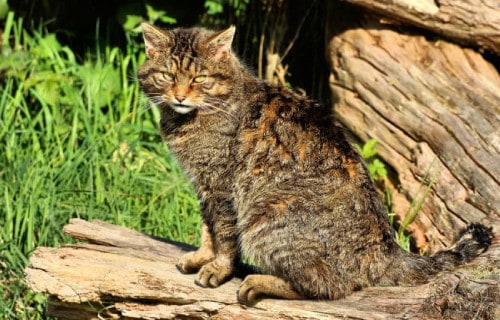
CCL: https://bit.ly/1jxQJMa
Scottish Wildcat Facts
- Next on our list of Wonderful Wild Cats of the World is the remarkably unexpected Scottish Wildcat.
- The truly surprising animal constitutes a variety of wild feline that virtually no one outside of its endemic range even knows about. Such a terrible shame.
- This rather adorable feline itself actually constitutes a subspecies of the equally little-known outside of its immediate area, European wildcat.
- Sadly, like many related species, this animal also faces serious threats to its continued existence. At present, estimates place its total population at no more than 300 individuals, perhaps fewer.
- In addition to climate change and habitat loss, it also faces the added threat of interbreeding with domestic felines, given its small physical size.
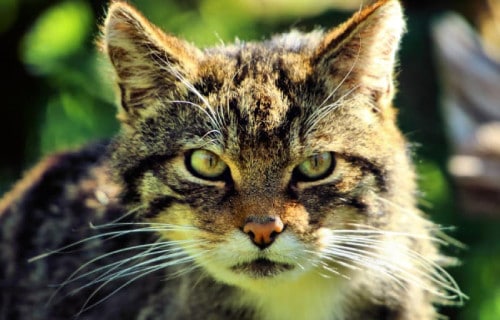
CCL: https://bit.ly/1jxQJMa
Scottish Wildcat Physical Description
The Scottish Wildcat has a rather striking appearance, to be certain. Nonetheless, it ranks as a rather small species of a wild feline, compared to others.
Like many animals, it displays a moderate degree of sexual dimorphism. In its case, the physical size represents the most obvious example of the principle.
Adult males attain an average weight of about 16 lb (7.2 kg), while the smaller females only average weight of about 10.3 lb (4.7 kg).
The coats have a tabby-like patterning, similar to many domestic cats, minus the white feet. The tail grows thick, with a ringed pattern.
Uniquely, and rather interestingly, the ears of this feline have the ability to rotate a full 180 degrees. This provides a decided advantage in its native environment.
- Kingdom: Animalia
- Phylum: Chordata
- Class: Mammalia
- Order: Carnivora
- Family: Felidae
- Genus: Felis
- Species: F. silvestris
- Subspecies: F. s. grampia
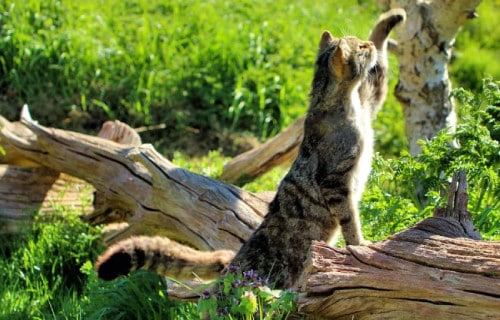
CCL: https://bit.ly/1jxQJMa
Scottish Wildcat Distribution, Habitat, and Ecology
The endemic range of the Scottish Wildcat once included much of what now constitutes Wales and England. Yet sadly for the world, that no longer holds true.
Currently, its habitat range only covers portions of Scotland, in Europe, hence the common name. It became extinct in the other portions of its range in the last 150 years, primarily due to human activity.
Its preferred habitat consists of areas of shrubland and woodland. However, the ongoing disappearance of such regions occasionally forces it to also encroach upon human population centers.
Experts estimate its lifespan in the wild to be only 2-3 years, though it often lives for as long as 15 years in captivity. In the wild, individuals also frequently fall prey to diseases from feral cats and encounters with vehicles.
This rather gorgeous mammal generally lives in a small den. These it usually constructs beneath tree roots, or in brush piles or cairns. Litter size may be as many as 8 kittens.
Its activity may be either nocturnal or crepuscular. At these times, it hunts small prey, usually including rabbits, mice, and voles. Individual territories typically remain relatively small.
Golden Tabby Tiger
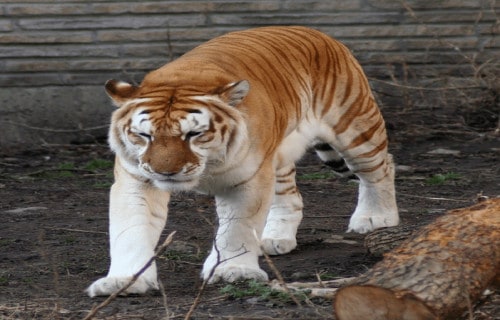
Golden Tabby Tiger Facts
- Though not technically a species in its own right, the beautiful Golden Tabby Tiger comes next on our list of Wonderful Wild Cats of the World.
- It currently lists as the third rarest creature on earth. With almost absolute certainty, no survivors exist in the wild and only 30 in captivity.
- Not technically a separate species, it represents the result of a recessive gene arising from the inter-breeding of a Bengal and an Amur tiger.
- This occurred in captivity in the early 20th century. In effect, it represents a mutation. Our moral compass here questions why this species exists at all.
- The colors of this mammal’s coat are lighter than that of other tigers and would be an actual disadvantage in the wild, as a result of reduced camouflage capability. Humans cannot create something better than Nature would.
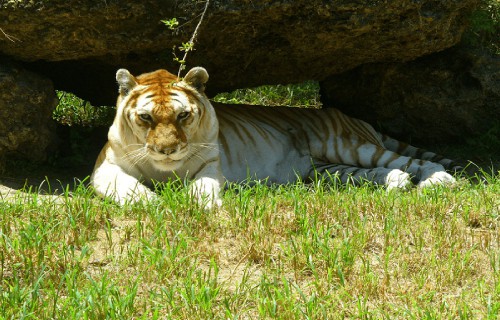
Golden Tabby Tiger Mutation
Although an individual Golden Tabby Tiger can occur in the wild, none are known to exist at this time – for the better.
An unknown individual in India, in Asia, in the early 20th century killed the last known wild Golden Tabby Tiger in existence.
For reasons which scientists have yet to clarify, all of these tigers actually develop slightly larger than even the mighty Bengal Tiger.
This makes this mutated version the largest of all known tigers, though it still isn’t a separate species.
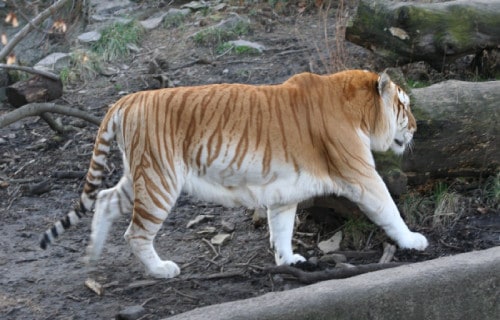
Golden Tabby Tiger Research
Scientific research involving this particular variety of the majestic tiger remains scarce due to its limited numbers.
Yet, researchers have made one rather interesting observation. Various tests indicate that the Golden Tabby Tiger also appears to be slightly more intelligent than other tigers.
Every single known Golden Tabby Tiger alive today constitutes a direct descendant of a mixed breed tiger named Tony, via the only one of his many descendants to successfully breed, a male named Bhim.
Borneo Bay Cat
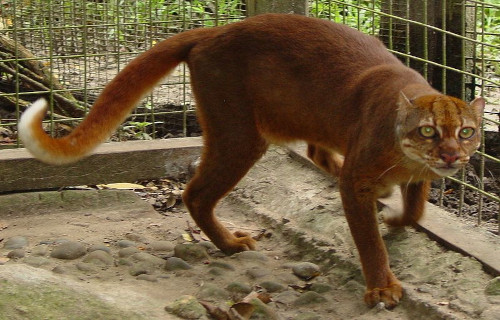
CCL: https://bit.ly/3CqmfXq
Borneo Bay Cat Facts
- Next on our listing of Wonderful Wild Cats of the World is the fascinating Borneo Bay Cat.
- This animal is an extremely reclusive wildcat. No sightings occur outside of its native forest. It actually appears to be the Howard Hughes of the feline world.
- In 2002, the IUCN classified this species as Endangered. An exact count of its numbers remains unknown, but it is rarely seen, and its area of habitation seems severely restricted.
- Estimates place the total extant population of Borneo Bay Cat at fewer than 2,000. Given the restricted range, experts consider habitat loss (as usual) its primary threat.
- The cat seems to be highly specialized in its habitat requirements since no specimens have ever been seen outside the forest.
- We still know very little about the ecology or reproductive behavior of this amazing feline.
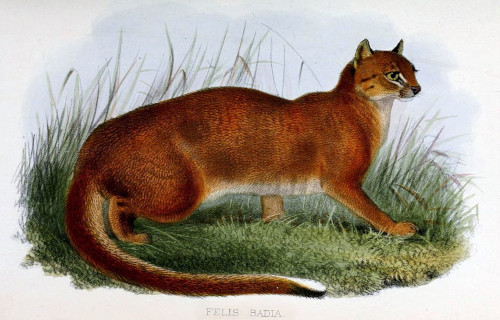
Image: Zoological Society of London
Public Domain Image
Borneo Bay Cat Physical Description
Since the discovery of the Borneo Bay Cat in 1874, the number of specimens studied firsthand only totals 12 individuals (imagine – only 12 in 141 years), so data on its size and weight can only be based on those scant few.
Based on the few examined to date, the species attains a maximum body length of about 26.4 in (67 cm), and a weight of roughly 8.8 lb (4 kg).
The tail of the Borneo Bay Cat averages nearly 16 in (40 cm) long. Its overall coloring remains a chestnut shade, and slightly lighter on the underbelly.
The ears develop somewhat rounded in shape (rather like those of a human). Typically, two dark stripes spread outward from the corner of each eye. The Borneo Bay Cat also usually displays a distinctive dark marking on the back of the head, which stays roughly M-shaped.
- Kingdom: Animalia
- Phylum: Chordata
- Class: Mammalia
- Order: Carnivora
- Family: Felidae
- Genus: Catopuma
- Species: C. badia

CCL: https://bit.ly/3CqmfXq
Borneo Bay Cat Distribution, Habitat, and Behavior
The Borneo Bay Cat also apparently only exists in two concentrations deep within the interior section of the island of Borneo, in Asia (perhaps wisely hiding from man). Evidence also indicates that while it resides solely within the forest, it will inhabit varied types of forest habitats.
Portions of the forest in which the animal has been spotted include swamp forests and highland forests, at altitudes of as much as 1,600 ft (500 m) above sea level. The greatest concentration of either confirmed sightings or evidence of its presence occurred in the Gunung Mulu National Park.
All sightings of the Borneo Bay Cat have been in the vicinity of water, suggesting a rather close association (perhaps it actually likes to swim). Currently, we know nothing about where this species prefers to make its dens.
Evidence gained from camera traps placed in the region indicates that it primarily feeds as a nocturnal creature.
Cougar
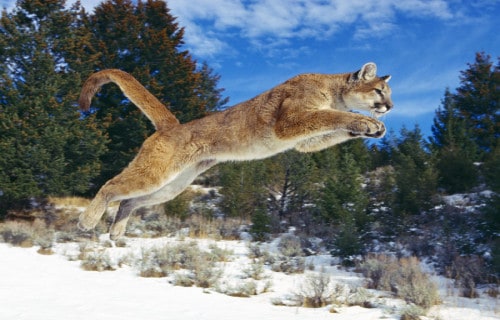
Cougar Facts
- The next animal on our list of Wonderful Wild Cats of the World is the sleek and beautiful Cougar.
- The cougar, Puma concolor, is a gorgeous large feline native to the Americas, and it is more nearly similar to smaller felines, including the domestic cat than to any other known subspecies of the lion.
- This feline is a slender and agile member of the cat family and is also the fourth-largest feline species.
- The mammal is adept at climbing, which allows it to evade canine competitors. Although not strongly associated with water, the cougar can swim.
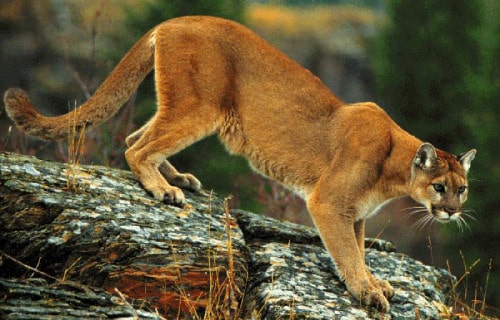
Cougar Physical Description
The Cougar exhibits sexual dimorphism in terms of size. Adults average roughly 24-35 in (60-90 cm) tall at the shoulders. Adult males are also about 7.9 ft (2.4 m) long, nose-to-tail, and females are usually up to 6.7 ft (2.05 m).
On the other hand, of this length, 25-37 in (63-95 cm) of this is only the tail.
The male typically weighs 115-220 lbs (53-100 kg) while females – between 64-141 lbs (29-64 kg).
The head of the mammal is round and its ears are erect. Its powerful forequarters, neck, and jaw serve to grasp and hold large prey.
It also has five retractable claws on the forepaws and four on the hind paws. The larger front feet and claws are adaptations to clutching prey.
In addition, it has large paws and proportionally the largest hind legs in the cat family.
- Kingdom: Animalia
- Phylum: Chordata
- Class: Mammalia
- Order: Carnivora
- Family: Felidae
- Genus: Puma
- Species: P. concolor
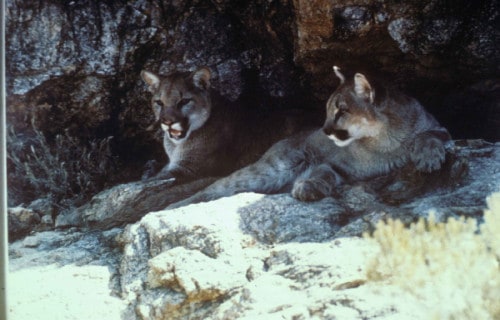
Cougar Distribution, Habitat, and Ecology
The rather stunning Cougar also has the greatest range of any wildcat in North America. Consequently, it can be found from parts of Canada to the Andes in South America.
It has also evolved to be highly adaptable, and thus inhabits a wide variety of habitat types within its native range. These include forests, lowlands, mountains, and arid climates.
This physique allows the Cougar some of the greatest leaping and short-sprint ability of any animal. It is able to jump as high as 18 ft (5.5 m) in one bound, and as far as 40-45 ft (12-14 m) horizontally.
The top running speed of the animal also ranges between 40-50 mph (64-80 kph), but they are best capable of short, powerful sprints rather than long chases.
A rather successful generalist predator, the Cougar will eat any animal it can catch, from insects to large ungulates in excess of 1,100 lbs (500 kg). Certainly, it exhibits opportunistic behavior.
Like all felines, it is an obligate carnivore. This means that it needs to feed exclusively on meat to survive. Investigations in Yellowstone National Park showed that elk, followed by mule deer, were the animal’s primary targets.
Andean Mountain Cat
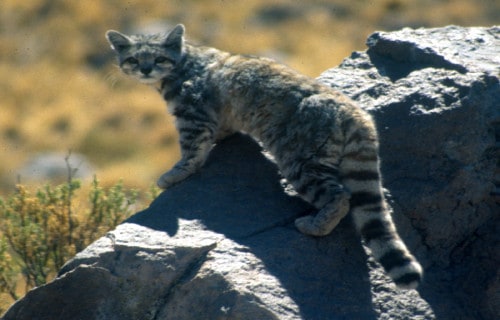
CCL: http://bit.ly/2IjEG4n
Andean Mountain Cat Facts
- The Andean Mountain Cat, Leopardus jacobita, is next in this article on Wonderful Wild Cats of the World.
- It is a small species of wildcat. It is also one of only two species of wild felines for which no subspecies have been classically described.
- The beautiful small cat is, unfortunately, an extremely rare creature. Estimates place the number of living individuals to be no more than 2,500.
- The Leopardus jacobita is one of approximately two dozen small wildcat species found around the world and ranks among the least known of all wild felines.
- Sadly, the IUCN currently lists this remarkable feline as Endangered. The greatest threats to its existence are habitat loss and climate change.
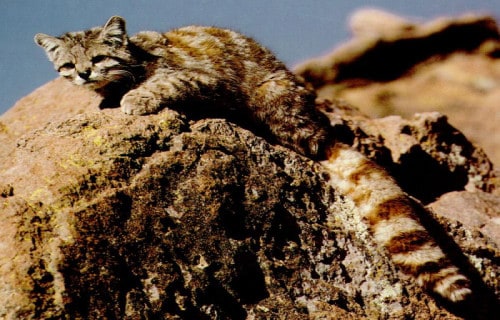
Andean Mountain Cat Physical Description
Generally, the top coat of an Andean Mountain Cat is silvery-grey in color. Commonly the underside is white, with numerous dark spots and stripes.
It also possesses black rings around the tail and limbs. Body length may reach as much as 25 in (64 cm) and tail may reach 19 in. (48 cm).
The Leopardus jacobita averages about 14 in (36 cm) at the shoulder and weighs about 12 lb. (5.5 kg).
The tail is long, thick and blunt without tapering. The front paws have dark narrow stripes that do not form complete rings. The nose is black or very dark in coloration.
There is a difference between the color patterns in juvenile and mature Andean Mountain Cats. The markings on the coat are smaller, more numerous, and darker on juveniles, especially those on the sides of the body.
- Kingdom: Animalia
- Phylum: Chordata
- Class: Mammalia
- Order: Carnivora
- Family: Felidae
- Genus: Leopardus
- Species: L. jacobita

CCL: https://bit.ly/3CmJaD3
Andean Mountain Cat Habitat and Distribution
Scientists believe that the Andean Mountain Cat lives only in Bolivia, Chile, Peru, and Argentina, in South America. The felines prefer high-elevation treeless habitat, where the conditions are very dry, windy, and cold.
Those areas are also fragmented by deep valleys. Additionally, its distribution is likely to be further localized by the patchy nature of colonies of the preferred prey.
The Andean Mountain Cat lives at altitudes of between 11,500-15,700 ft. (3,500-4,800 m) in elevation. Though it is about the size of a domestic cat, it appears larger because of its long tail and thick fur.
Its diet consists primarily of the mountain viscacha which is a type of rodent.
Unfortunately, estimates place the wildcat’s numbers in a rapid decline. This is primarily due to a loss of habitat (mining, cattle lands, etc.) as well as a decline in the numbers of its prey.
The feline would also hunt mountain chinchillas which are also in rapid decline due to hunting for the fur trade. Also, people in Chile and Bolivia often kill them because of local superstitions.
Since the creature lives only in the high rocky mountains, human-inhabited valleys act as barriers. This fragments the population even further, meaning that even low levels of poaching could be devastating.
Cheetah
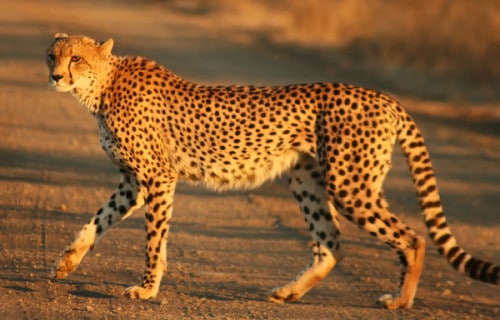
CCL: http://bit.ly/2QZT99x
Cheetah Facts
- The next of our Wonderful Wild Cats of the World is the fleet Cheetah. It is a large species of wild feline inhabiting most of Africa and portions of the Middle East. It remains the only surviving members of the genus Acinonyx.
- The mesmerizing animal also ranks as the fastest of all known land animals. It is capable of attaining speeds of as much as 75 mph (120 kph).
- However, this speed is only in short bursts covering distances up to 1,600 ft (500 m). It also has the ability to accelerate from a standstill to 60 mph (96 kph) in as little as 3 sec.
- The Cheetah is believed to have evolved in Africa during the Miocene Epoch (26-7.5 million years ago).
- Evidence indicates that it then migrated to Asia. Recent research places the last common ancestor of all existing populations in Asia 11 million years ago.
- Currently, at least six known sub-species exist.
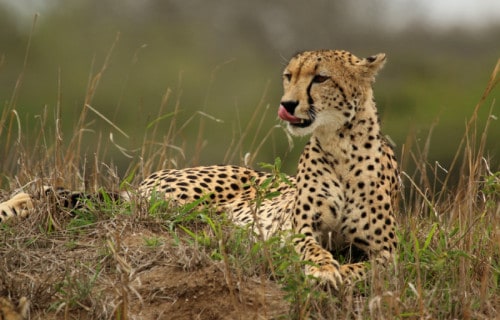
CCL: http://bit.ly/2zBWbKi
Cheetah Physical Description
The Cheetah possesses a rather narrow waist and deep chest. The fur also grows short and coarse. The animal is primarily tan in color, with round black spots.
These spots typically measure approximately 0.8-1.2 in. (2-3 cm) in diameter. No noticeable sexual dimorphism is present in the species.
This color pattern provides natural camouflage. The underside is white, with no spots, and the tail has spots which merge to form four to six dark rings at the end.
The Cheetah has a small head, with high-set eyes. Their thin and fragile body makes them well suited to short bursts of high speed. However, they are not suited for endurance, yet they remain extremely agile creatures.
An adult may weigh as much as 159 lbs (72 kg), while the body length of the Cheetah averages about 59 in (150 cm). The tail averages roughly 24-33 in (60-84 cm) in length.
- Kingdom: Animalia
- Phylum: Chordata
- Class: Mammalia
- Order: Carnivora
- Family: Felidae
- Genus: Acinonyx
- Species: A. jubatus
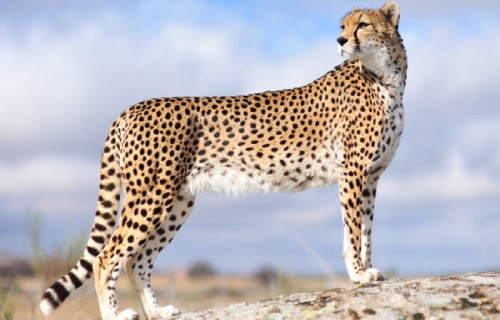
Cheetah Distribution, Habitat, and Ecology
Currently, several populations of Cheetah exist, isolated geographically. All of these occur in either Africa or southwestern Asia. Additionally, a small population still survives in the Khorasan Province of Iran.
There, conservation efforts are underway to protect the survivors. There have also been unconfirmed reports of sightings in both India and Pakistan.
The Cheetah prefers large stretches of land, with abundant prey. It typically thrives in savannas, grasslands, and mountainous regions.
Males tend to form groups, often for life, yet the females are generally more solitary. The two sexes rarely intermingle, except for mating purposes. Except for the time spent rearing the young, the females live alone.
The stunning mammal also forms one of only four species of cat with semi-retractable claws. Interestingly, the Cheetah remains capable of purring, but not roaring.
Kodkod
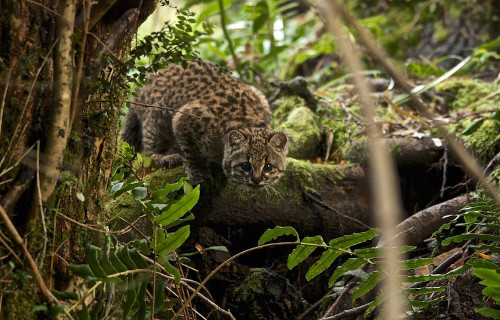
CCL: https://bit.ly/3AqJ7UY
Kodkod Facts
- The next of our Wonderful Wild Cats of the World is adorable Kodkod. It is a wildcat species which surprises many who learn of its existence. That’s because this remarkable animal grows no larger than the average house cat.
- Many people do not even know of the cat’s existence because the Kodkod’s range of habitation is highly limited and typically remote. This includes rainforests and extreme elevations.
- Also, its already limited numbers are decreasing rapidly. The IUCN lists the animal as Vulnerable and indicates that the animal’s population now numbers less than 10,000 individuals.
- This species faces numerous threats like climate change and habitat loss due to deforestation. Also, local inhabitants often kill it in retaliation for raiding their livestock, most notably chickens.
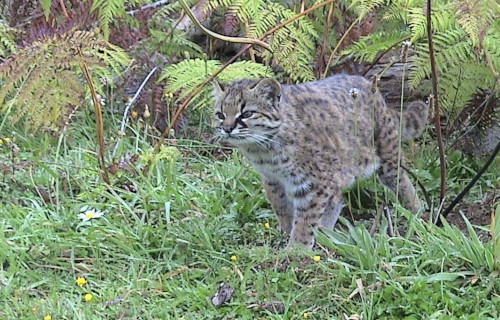
CCL: https://bit.ly/3yynC41
Kodkod Physical Description
While the Kodkod holds the classification of a wildcat, its size nevertheless remains rather diminutive.
Much as with other felines, either wild or domesticated, it does not display sexual dimorphism. The feline attains an average body length of 20 in, and the short tail averages 9.8 in (25 cm) in length.
The species also reaches an average height at the shoulder of just under 10 in (25.4 cm). The average adult, of either gender, weighs roughly 5.5 lb (2.5 kg). It also has a relatively small head, while its feet rank as relatively large for a feline of its size.
While short, the tail grows comparatively thick. The primary color of the coat ranges from dark yellow to grayish brown. In addition, the body displays numerous dark spots and a ringed tail.
- Kingdom: Animalia
- Phylum: Chordata
- Class: Mammalia
- Order: Carnivora
- Family: Felidae
- Genus: Leopardus
- Species: L. guigna

CCL: https://bit.ly/3AqJ7UY
Kodkod Distribution, Habitat, and Ecology
The lovely Kodkod ranks as the smallest wildcat in either North America or South America. But it also has the smallest endemic territory. While a small population exists in Argentina, the vast majority of the population resides in central and southern Chile.
Incidentally, it also inhabits a highly specific habitat within that range. Except where forced out by human activity, individuals only inhabit regions of the temperate rainforests of the southern Andes.
The greatest concentrations exist in the Valdivian and Araucaria forests, which possess high concentrations of bamboo. There, its presence ranges up to elevations of as much as 6,200 ft (1,900 m).
These small carnivores hunt by both day and night and feed on a variety of small prey. This typically includes lizards, birds, rodents, and even large insects, such as moths.
Since the Kodkod possesses excellent climbing skills, the impressive small mammal spends as much time in trees as on the ground.
Pallas Cat
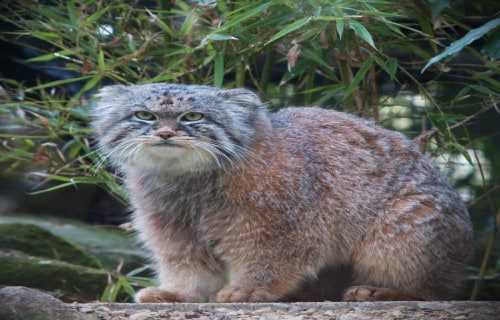
Pallas Cat Facts
- Any listing of Wonderful Wild Cats of the World would be incomplete without mentioning in Palls Cat.
- This stunner is a small species of wildcat. It appears endemic to the montane steppes and grasslands of Central Asia.
- Its distribution throughout the greater extent of this range seems to be highly fragmented, however.
- Interestingly, the Pallas Cat also lives as a predominantly solitary animal. Like most species of wildcat, it uses scent to mark its territory.
- Unfortunately, its numbers seem to be declining rapidly. Consequently, IUCN classifies it as Near Threatened.
- People still hunt it for its fur in Mongolia, Russia, and China. It occasionally gets caught in traps set for other animals, such as marmots. Domestic dogs also pose a common threat.
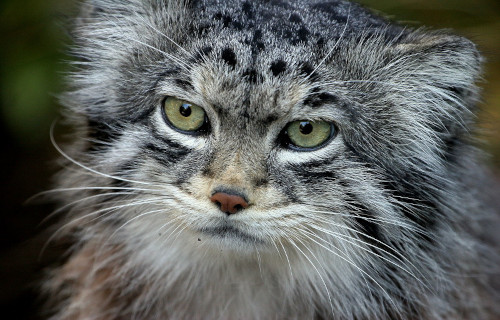
CCL: https://bit.ly/3xyxbOQ
Pallas Cat Physical Description
Physically, the Pallas Cat measures about the same size as the average domesticated feline. It also appears to be much bulkier due to its extremely long, dense fur.
In fact, the species averages a body length of as much as 26 in (65 cm) and the tail averages 12 in (31 cm) in length.
Weights vary greatly between individuals but reach as much as 10 lb (4.5 kg). The legs grow comparatively short, adding to its rather stocky appearance.
Further, the fur typically shows an ocher color in summer, and grayish in the winter. The ears are set very low, and wide apart, and the claws are extremely short for a feline.
- Kingdom: Animalia
- Phylum: Chordata
- Class: Mammalia
- Order: Carnivora
- Family: Felidae
- Genus: Otocolobus
- Species: O. manul
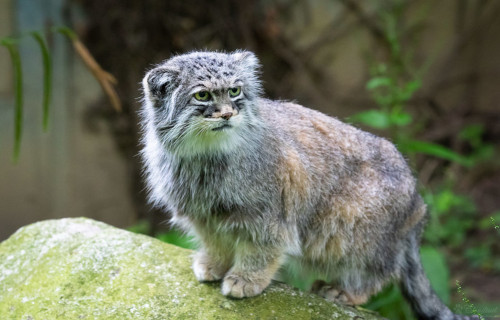
CCL: https://bit.ly/3xxEvKS
Pallas Cat Distribution, Habitat, and Ecology
The Pallas Cat lives in portions of the Tibetan Plateau. There, it inhabits territories of Tajikistan, Mongolia, Pakistan, Kashmir, and much of western China and dwells as high as 16,570 ft (5,050 m).
The species primarily preys upon wild gerbils, voles, pikas, and partridges. It also has a diurnal nature and spends the majority of the day in rock crevices, caves, or marmot burrows.
Individuals typically hunt late in the afternoon and are not fast runners, so principally hunt as ambush predators.
The Pallas Cat also has an average lifespan of roughly 11 years.
Amur Leopard
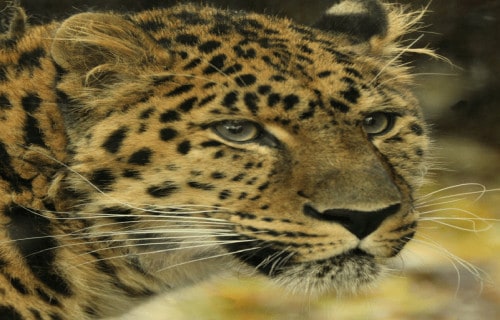
CCL: https://bit.ly/1jxQJMa
Amur Leopard Facts
- The Amur Leopard or the Far Eastern Leopard lists next on this compilation of Wonderful Wild Cats of the World.
- The terms serve as the common names of a species of leopard native to restricted portions of Asia.
- The species also remains extremely rare, and IUCN lists it currently as Critically Endangered, with barely than 100 individuals known to still exist in the wild.
- This itself represents an increase in numbers. Just a few years before, when protections were instituted, it numbered no more than 40 individuals.
- The greatest threats to the continued existence of this magnificent feline continue to be habitat loss and also poaching by hunters.
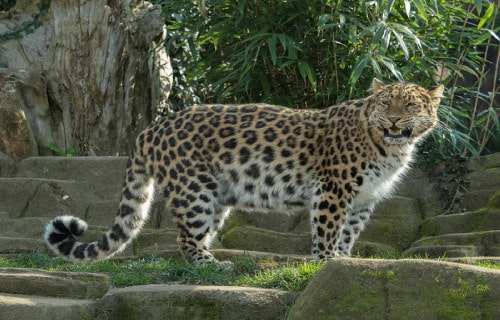
Amur Leopard Physical Description
The rather gorgeous Amur Leopard remains different from other leopards in that its fur coat is very thick. The fur is long, dense, and quite soft.
Large males may attain a body length of as much as 54 inches (136 cm) plus a tail averaging 35 in (90 cm). Males may stand as much as 31 in (78 cm) high at the shoulder, and weigh as much as 110 pounds (48 kg).
Its fur generally changes color with the seasons. The winter coat varies from fairly light yellow to dense yellowish-red. The rest of the year, it generally presents a pale cream color.
- Kingdom: Animalia
- Phylum: Chordata
- Class: Mammalia
- Order: Carnivora
- Family: Felidae
- Genus: Panthera
- Species: P. p. orientalis
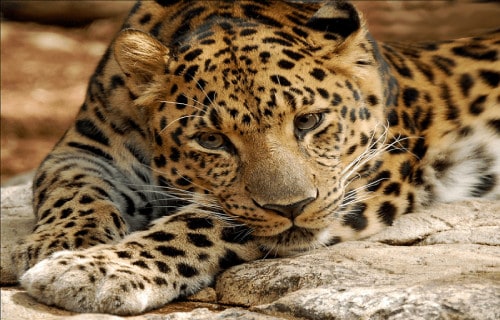
CCL: https://bit.ly/1jxQJMa
Amur Leopard Distribution, Habitat, and Ecology
The stunning Amur Leopard historically inhabited a range that included Eastern Siberia, Northern China, and portions of Korea. Today, that range has shrunk to only include a small portion of the border between Russia and China.
It only inhabits rugged mountainous regions, especially snow-free south-facing rocky slopes in winter.
It also feeds as an opportunistic hunter and will take prey ranging in size from as small as a mouse to as large as a moose.
The greatest threats to this magnificent animal are habitat loss and also climate change, as it has evolved to inhabit cold climates.
Numerous conservation programs are also underway, including potentially reintroducing captive-bred individuals from zoos from around the world, which has been under consideration since 1996.
It would be such a shame to lose this marvelous feline so we hope the program works.
Ocelot
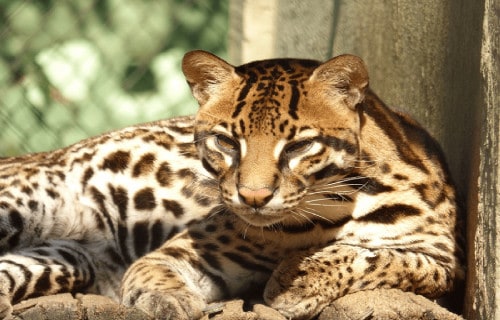
Ocelot Facts
- No article concerning the Wonderful Wild Cats of the World would be complete without the presence of the Ocelot.
- While most wildcats see their numbers dwindling rapidly, the beautiful Ocelot holds the distinction of being one of the few wild felines that the IUCN lists as a Species of Least Concern.
- Previously, it had been listed as Endangered until 1996. As of that time, efforts at protecting the creature had allowed its numbers to bounce back significantly.
- In the past, the Ocelot was widely hunted for its pelt, which was regarded as highly valuable. Thankfully, this practice was banned decades ago throughout its endemic territory.
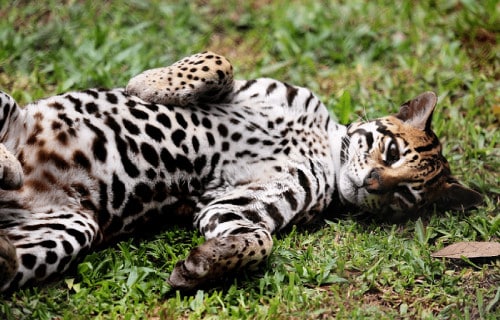
Ocelot Physical Description
The remarkable Ocelot lists as a moderate-sized variety of wildcat. The species also displays a moderate degree of sexual dimorphism. Females weigh as much as 25 lb (11.3 kg) while males reach a weight of as much as 34 lb (15 .5 kg).
This beautiful mammal attains an average overall body length of between 22 – 39 in (55 – 100 cm). The tail adds an additional 10 – 16 in (25.5 – 41 cm) to the total length of the feline.
In color, the fur of the Ocelot is predominantly a tawny yellow with numerous black markings. The neck and belly typically display a white coloring. Its fur usually remains short on the belly but grows longer on the back.
The small ears also usually remain rounded and display a prominent white spot. The eyes most commonly show a brown color that reflects patterns of gold in bright light.
- Kingdom: Animalia
- Phylum: Chordata
- Class: Mammalia
- Order: Carnivora
- Family: Felidae
- Genus: Leopardus
- Species: L. paradis
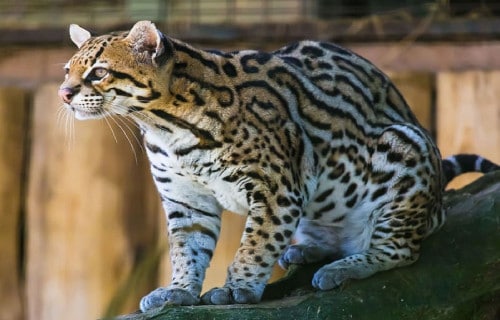
CCL: https://bit.ly/1ryPA8o
Ocelot Distribution, Habitat, and Ecology
The actual range of the amazing Ocelot covers an extensive region which extends through portions of the United States, in North America, through Mexico and much of Central Ameria and South America.
Population densities also vary rather widely, however, with the highest known density occurring in Panama.
This particular animal inhabits a rather wide range of habitats, which has helped its numbers to rebound from a few decades ago.
These habitat types include tropical rainforests, scrublands, mangrove forests, and even coastal marshes. It typically prefers lower elevations, but some populations occur as high as 9,843 ft (3,000 m).
Like all wildcats, the Ocelot also has a carnivorous diet. Its primary prey consists of such small animals as rabbits, rodents, fish, birds, opossums, armadillos, and occasionally small reptiles and even insects.
Hunting typically occurs during the evening and at night, but sometimes happens during the day when necessary.
Snow Leopard

CCL: http://bit.ly/2xLZ0ap
Snow Leopard Facts
- Of all the Wonderful Wild Cats of the World, the Snow Leopard easily ranks as one of the most beautiful and majestic.
- Because of its majestic beauty, the gorgeous Snow Leopard is the National Heritage Animal in two countries within its territorial range. As a result, it is afforded a measure of protection.
- It ranks among the most beautiful of the big cats and is also the least aggressive towards humans. These felines are reportedly easily driven away from livestock.
- Unfortunately, this remarkable wild feline is also in danger of extinction. The IUCN listed the species as Threatened.
- Climate change and habitat loss represent the greatest threats to its continued existence as a species.
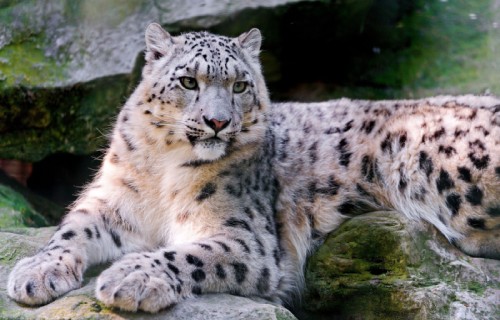
Snow Leopard Physical Description
The Snow Leopard is slightly smaller than other big cats.
The body is stocky in shape, averaging about 50 in (130 cm) in length. It achieves a usual weight of about 120 lb (55 kg). The legs are rather short, with the feline measuring an average of 24 in (60 cm) at the shoulder. The tail is long, averaging 39 in (100 cm) long.
Its evolutionary adaptations include the well-known stocky build, much thicker fur, smaller ears, and wider paws.
The Snow Leopard is also capable of leaping as much as 50 ft (15.2 m).
Its coloring varies between individuals. This range runs from a smoky gray to a tan color, with the ubiquitous spots. These patterns provide for excellent camouflage within its endemic habitat.
The eyes are very distinctive and are typically gray or pale green in color. Occasional individuals are born with a brilliant blue variant.
- Kingdom: Animalia
- Phylum: Chordata
- Class: Mammalia
- Order: Carnivora
- Family: Felidae
- Genus: Panthera
- Species: P. uncia
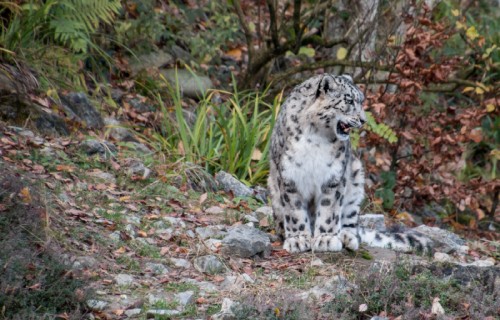
Snow Leopard Distribution, Habitat, and Ecology
The Snow Leopard is endemic to a specific portion of Central and Southern Asia. Within that range, it remains restricted to the upper mountain ranges, in Afghanistan, and Pakistan
The species inhabits both the alpine and sub-alpine ranges. It lives at altitudes of between 9,800 – 14,800 ft (3,000 – 4,500 m) and prefers terrain that is rocky or snow-covered.
Its active periods are generally at twilight. The species is primarily carnivorous and is an excellent hunter. Individuals typically take smaller prey such as rabbits and birds but will occasionally take prey several times its own size. This stunning animal also feeds opportunistically, consuming carrion.
This species consumes a proportionately larger amount of vegetation than any other big cat.
The feline leads a primarily solitary life as it usually only groups together to mate or while a female is rearing her cubs.
In addition, a typical lifespan is approximately 15-18 years.

Snow Leopard Conservation Efforts
The Snow Leopard faces the danger of extinction. Exact tallies of its numbers in the wild are impossible to attain because of the remoteness of its habitat. Current estimates place its numbers at fewer than 8,700.
Numerous organizations are now working to preserve the species. In 2013, the governments of 12 of the countries the Snow Leopard inhabits signed the Bishkek Declaration.
Consequently, they created numerous protected areas within the range the felines inhabit. To date, a total of 23 of these protected areas exist. A few of these include Chitral National Park, in Afghanistan, and Tumor Feng Nature Reserve, in China.
Yet, more must be done: illegal poaching still occurs as well as a threat from habitat loss.
Pampas Cat
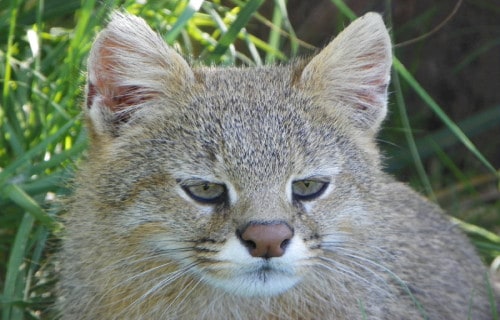
Pampas Cat Facts
- Here, on our compendium of Wonderful Wild Cats of the World, we have the diminutive Pampas Cat.
- This mammal is a rather small species of wildcat. The name derives from the fact that it principally inhabits areas of pampas
- The small wild feline also currently holds a listing with the IUCN of Near Threatened
- Habitat destruction is the greatest threat to the survival of this animal. It remains rarely seen and has been little studied hence very little is known of the hunting or breeding habits of this animal.
- Limited evidence also suggests that it principally preys upon birds and rodents. It also appears to be primarily nocturnal in nature.
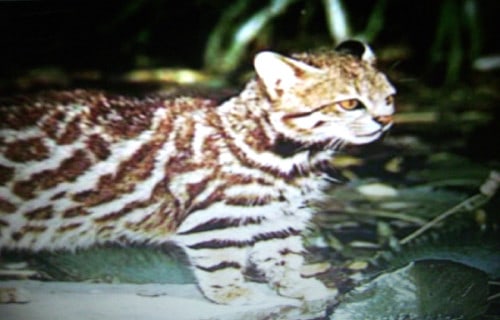
CCL: http://bit.ly/2IjEG4n
Pampas Cat Physical Description
Though small in stature, the Pampas Cat possesses a relatively stocky build. Average sizes vary greatly, based upon geographical locations. Average body length ranges from 18-30 in (46-75 cm).
The tail of this beautiful species stays comparatively short, and averages 9.1-11.4 in (23-29 cm) in length, again depending upon geographical factors.
In a rather fascinating evolutionary adaptation, this feline species also displays three distinctly different variations in pelage.
However, all three present two dark lines on each cheek. Typically, individuals of each pelage variation remain restricted to a particular territory range.
One is found only in the extreme north, and yet another appears only on the far southern edge of its territory. Those found in between comprise the greater majority of pelage type.
- Kingdom: Animalia
- Phylum: Chordata
- Class: Mammalia
- Order: Carnivora
- Family: Felidae
- Genus: Leopardus
- Species: L. colocola

Pampas Cat Habitat
The name of the Pampas Cat reflects its preference for inhabiting regions of pampas. However, individuals do also occur in a wide variety of habitat types.
These animals sometimes appear in Argentina, Bolivia, Chile, Ecuador, and Peru, in South America. Within that region, it will also inhabit a wide range of altitude.
The Pampas Cat most commonly occurs at altitudes ranging from 5,900-16,400 ft (1,800-5,000 m). In addition to the pampas, it sometimes inhabits several other types of habitat.
These include dry forests, grassland, and shrubland, as well as occasionally the Patagonian steppes. It often shares territory with other varieties of the wildcat.
Flat Headed Cat
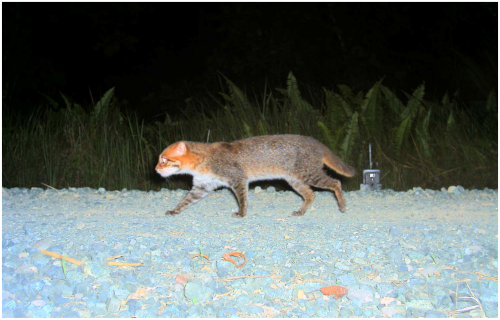
CCL: https://bit.ly/3CtebFf
Flat Headed Cat Facts
- The truly remarkable and unique Prionailurus planiceps, also known as the Flat Headed Cat, represents yet another extremely rare variety of wild feline. This assures its listing among the Wonderful Wild Cats of the World.
- Consequently, the IUCN currently lists it as Endangered, and habitat loss serves as the primary threat to its existence.
- Estimates of its current population place the number of extant individuals of this animal at no more than 2,500.
- The Flat Headed Cat also remains extremely rare in captivity. Fewer than 10 specimens presently exist in captivity all of which unfortunately live in zoos in Thailand and Malaysia.
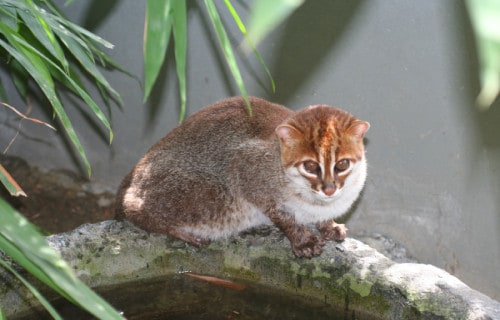
Flat Headed Cat Physical Description
The fascinating Flat Headed Cat draws its name from its rather distinctive cranial structure. Relative to other felines, its skull grows highly flattened.
The body stays generally slender in shape, and the legs of the mammal grow slightly longer than average for a feline. The species also possesses a unique dental structure as well.
In color, it typically shows a reddish brown to dark brown on top. The underbelly generally appears a mottled white in color.
Head and body length averages about 20 in (50 cm), and the tail averages roughly 6 in (15 cm) in length. The average weight also totals about 5.5 lb (2.5 kg).
Relative to body size, its canine teeth measure almost twice the length of other felines.
- Kingdom: Animalia
- Phylum: Chordata
- Class: Mammalia
- Order: Carnivora
- Family: Felidae
- Genus: Prionailurus
- Species: P. planiceps

CCL: https://bit.ly/3CtebFf
Flat Headed Cat Distribution and Habitat
The Flat Headed Cat is very restricted in its distribution. This animal is a small species of wild cat native to Borneo, Sumatra, and the Thai-Malay Peninsula, in Asia. Its distribution appears to be extremely patchy.
Within its native range, it occurs almost exclusively in tropical rainforests. Both primary and secondary such forests will be occupied.
The species primarily inhabits freshwater habitats within these forests. Its preference for proximity to water appears to be a common trait.
The rather impressive small mammal primarily consumes fish from small streams and ponds, although it will take other prey.
Very few specimens are observed more than 2 mi (3 km) from the water. The Flat Headed Cat also appears to prefer sections of rainforest either in lowland areas or near coastal regions.
Margay
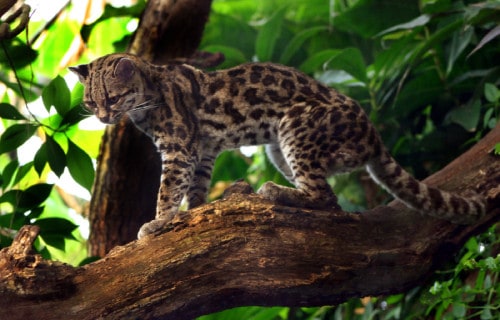
CCL: http://bit.ly/2IjEG4n
Margay Facts
- This awesome small feline is the next member of our roster of Wonderful Wild Cats of the World, the Margay.
- The Margay is a spotted feline native to North America and South America and also an extremely solitary type of wildcat.
- The feline also remains a predominantly nocturnal animal and typically prefers extremely remote sections within its native range.
- The IUCN lists the Margay as Near Threatened. In some regions, people hunt an average of 14,000 of these wildcats for the fur each year which has resulted in an extreme decrease in population.
- In addition, habitat loss and climate change continue to present extreme challenges to the reclusive small mammal.
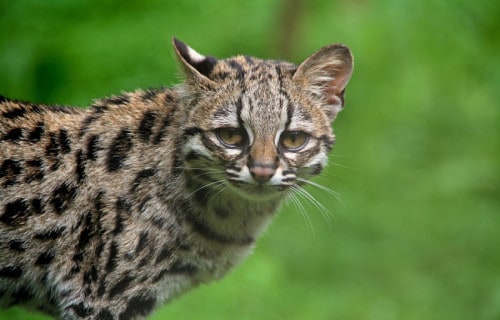
CCL: http://bit.ly/2IjEG4n
Margay Physical Description
The Margay only attains a weight of as much as 8.8 lb (4 kg). The body length averages about 31 in (79 cm) and the tail measures roughly 20 in (51 cm) in length.
Its fur displays a light brown and appears splotched with dark brown or black blotches and streaks. The stomach is generally white, and the tail has multiple bands, with a black tip.
The rather remarkable Margay evolved to be principally arboreal in nature and individuals may spend their entire lives within the canopy, never coming down.
It also has a remarkable evolutionary adaptation in its ankles. These evolved to be so flexible that the cats can actually walk down a tree trunk headfirst.
The feline also remains one of only two known to possess this rather unique ability.
- Kingdom: Animalia
- Phylum: Chordata
- Class: Mammalia
- Order: Carnivora
- Family: Felidae
- Genus: Leopardus
- Species: L. wiedii
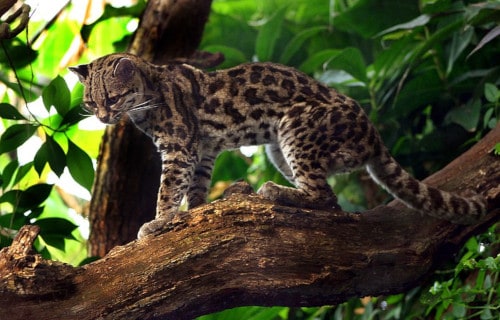
CCL: http://bit.ly/2IjEG4n
Margay Habitat and Distribution
The gorgeous Margay inhabits a range extending from southern Mexico to slightly beyond Central America.
This rather amazing wildcat lives almost exclusively in areas of dense forest with typical habitats including tropical dry forests, evergreen forests, and cloud (or fog) forests.
The Margay will also occasionally establish its territory in commercial plantations which unfortunately further increases its vulnerability to hunting.
Evidence also indicates that this beautiful creature once ranged as far north as the states of Georgia and Florida.
Arabian Sand Cat
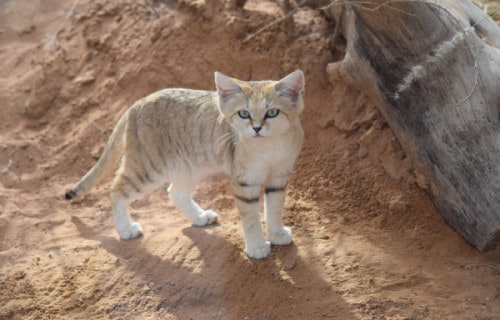
CCL: http://bit.ly/2zBWbKi
Arabian Sand Cat Facts
- The Arabian Sand Cat, also popular as the sand dune cat, forms the only feline that resides principally within the true desert.
- This rather fascinating feline species was first identified in 1858 when one was seen in the Sahara, quite by accident.
- In 2002, the IUCN originally listed the mammal as Near Threatened due to concerns about potential low population size and decline.
- However, in 2016, after reviewing promising new data, that status was significantly upgraded to Least Concern.
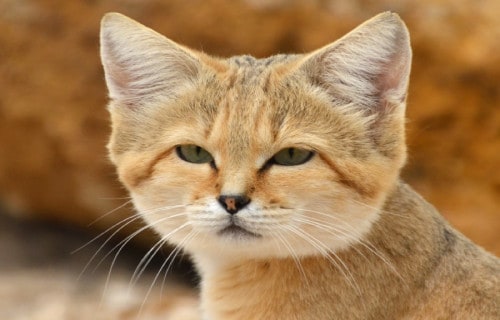
CCL: http://bit.ly/2zBWbKi
Arabian Sand Cat Physical Description
The Arabian Sand Cat represents a small species of a wildcat and seems to be highly adapted to its environment. It possesses a stocky build, with short legs and a rather long tail.
Individuals generally show a light tan in color and most commonly, the fur appears without spots or stripes. The chin, lips, belly, and throat display white. The ears show tawny brown at the base with a black tip.
This cat attains a body length of as much as 20 in (52 cm). The longer than average tail may also reach 12.2 in (1 cm) in length. Individuals could weigh up to 7.1 lb (3.2 kg).
The bottom of its paws becomes extremely thickly padded which naturally provides protection from the desert terrain. The ears grow large, compared to other small wild cats.
Acute hearing remains a survival necessity in an environment where prey stays scarce.
- Kingdom: Animalia
- Phylum: Chordata
- Class: Mammalia
- Order: Carnivora
- Family: Felidae
- Genus: Felis
- Species: F. margarita
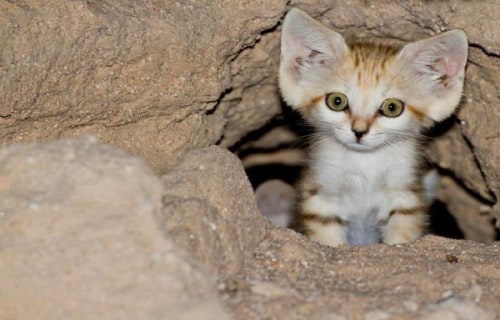
Arabian Sand Cat Habitat and Distribution
The magnificent Arabian Sand Cat appears to have a widespread, though disjointed distribution. It inhabits largely the deserts of northern Africa but also appears to be present in smaller populations in central and southwest Asia.
In North Africa, the cat appears in numerous locations including Morocco, the Sinai Peninsula, Egypt, Libya, Chad, and Sudan. In Asia, it lives in an area ranging from the Caspian Sea to the northern border of Afghanistan.
This feline likes both sandy and stony desert regions and they seem to prefer flat or undulating terrain with little vegetation. It also typically avoids bare sand dunes. In such locations, there is comparatively little food.
It remains capable of surviving in temperatures ranging from 23F-126F (-5C-52C). Individuals will withdraw to burrows during extreme conditions.
While the feline will, of course, drink when water is available, it can survive for months just on the water in its food.
Fishing Cat
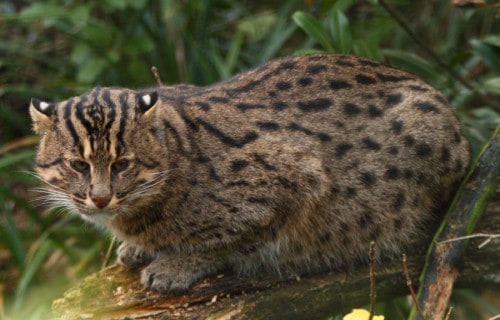
CCL: http://bit.ly/2xLZ0ap
Fishing Cat Facts
- Next on our list of Wonderful Wild Cats of the World is the remarkable species known as the Fishing Cat.
- This term serves as the common name for this species of animal. It remains a medium-sized wildcat, endemic to South Asia and Southeast Asia.
- Over the course of the last decade, its numbers dwindled dramatically. In 2008 the IUCN classified the Fishing Cat as Endangered, as a result.
- The principal reason for its decline remains habitat loss. The majority of its natural habitat has been converted to human use.
- Thankfully, the gorgeous small mammal now constitutes a protected species in most countries within its natural range.
- In some regions, its remaining habitat is being preserved, and captive breeding programs also now exist.
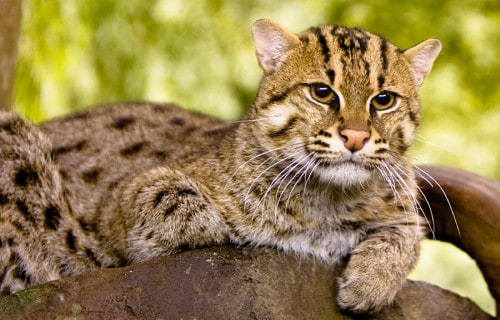
CCL: http://bit.ly/2xQPH8p
Fishing Cat Physical Description
The Fishing Cat possesses a stocky, muscular build. Its legs stay comparatively short, and the fur grows coarse in texture.
Its natural coloring typically presents an olive gray, and it also displays a series of dark spots on its coat. These are arranged in horizontal streaks along the entire length of the body.
The underbelly typically shows white, and the ears develop a deep black on the back. A mature Fishing Cat attains a head and body length of as much as 31 in (78 cm).
The tail also averages about 11.8 in (30 cm) in length. A large adult sometimes weighs as much as 35 lb (16 kg).
- Kingdom: Animalia
- Phylum: Chordata
- Class: Mammalia
- Order: Carnivora
- Family: Felidae
- Genus: Prionailurus
- Species: P. viverrinus

CCL: https://bit.ly/3s52QXd
Fishing Cat Distribution and Habitat
Fishing cat populations now exist only in widely scattered pockets throughout its native range. The majority of its numbers appear in the foothills of the Himalayas, in Nepal and India.
Other large concentrations exist in Sri Lanka and Bangladesh as well. The Fishing Cat also dwells exclusively in wetlands.
Individuals primarily live in marshes, swamps, and mangrove areas. The feline usually inhabits the area surrounding faster waterways only if necessary.
It typically prefers to inhabit both evergreen and tropical dry forests, provided they contain the proper, specific habitat type.
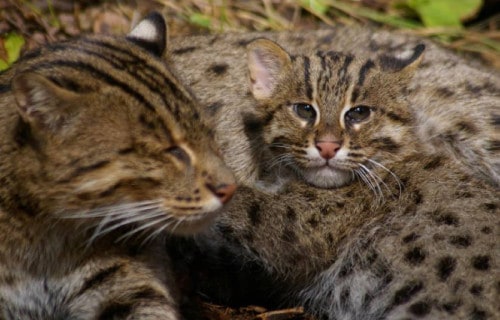
Fishing Cat Behavior and Ecology
The Fishing Cat derives its name from the fact that fish constitute its primary prey. Yet the mammal also consumes insects, reptiles, birds, and small rodents, and even carrion when available.
It forms a solitary species, usually congregating only to mate and remains principally nocturnal in nature. Unlike most felines, it seems quite comfortable in the water.
Researchers also note that the Fishing Cat sometimes swims great distances underwater in pursuit of prey.
Typically, however, it hunts the prey from along the bank. Individuals will not hesitate to dive in after a fish if necessary, however.
Black Footed Cat
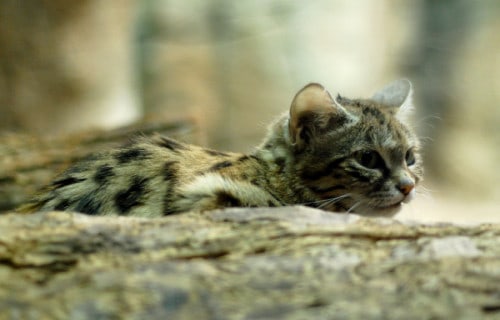
CCL: http://bit.ly/2xQPH8p
Black Footed Cat Facts
- The Black Footed Cat remains one of the smallest known species of a wild feline on earth. Can you believe that this adorable little creature actually ranks as a wildcat?
- It also has a highly solitary nature and almost completely nocturnal behavior. This animal rarely emerges from its resting places before sunset, at which time they hunt their prey.
- Due to these factors, men rarely see it, thus we still know little about them. Its numbers appear to be few, however, so the IUCN lists the Black Footed Cat as Vulnerable.
- Uniquely, it also seems to be a relatively poor climber for a feline and avoids climbing when possible.
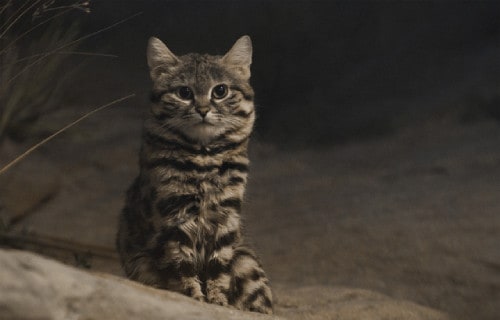
CCL: http://bit.ly/2xQPH8p
Black Footed Cat Physical Description
In spite of the descriptive name, only the bottom of the feet of the Black Footed Cat appears fully black in color (still, the name fits).
The species displays a moderate degree of sexual dimorphism. The adult male Black Footed Cat averages approximately 4.2 lb (1.9 kg) in weight, while the female usually only reaches 2.9 lb (1.3 kg) in weight.
The species remains smaller than many domesticated felines. Head to body length averages roughly 17 in (43 cm) among males while the female grows slightly shorter in length.
The ears have a rounded shape, and the eyes appear comparatively large.
The fur varies in color from tawny to cinnamon, with patterns of dark spots forming rings on various body locations.
- Kingdom: Animalia
- Phylum: Chordata
- Class: Mammalia
- Order: Carnivora
- Family: Felidae
- Genus: Felis
- Species: F. nigripes
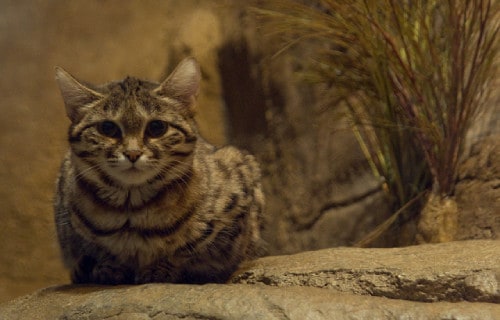
CCL: http://bit.ly/2zDnGC2
Black Footed Cat Habitat and Ecology
The Black Footed Cat remains native to portions of southern Africa. The animal only lives in Namibia, South Africa, and Zimbabwe.
It inhabits either grassland, savanna, and Karoo semi-desert. The Black Footed Cat prefers shrub and tree cover and may be found at altitudes of as much as 6,600 ft (2,000 m).
During the heat of the day, individuals will most typically inhabit small burrows or abandoned termite mounds.
The small felines remain extremely active hunters and typically catch a dozen or more small prey each night.
Individuals generally feed on such prey as small birds and rodents, though many will also consume insects and spiders opportunistically.
Caracal
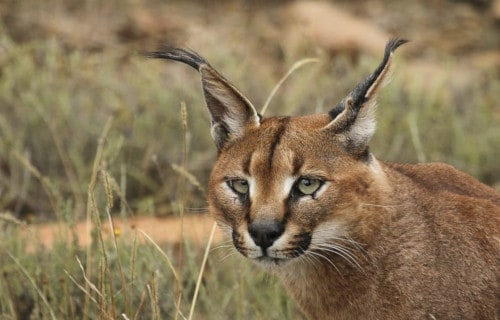
Caracal Facts
- Next, and certainly not least, on our list of Wonderful Wild Cats of the World is the magnificent Caracal.
- Firstly, while often confused with the Lynx, the truly gorgeous Caracal actually bears a closer relationship to other felines.
- However, unlike other wild felines, this beautiful animal has, sadly, been tamed and used for hunting for thousands of years.
- Also setting it apart from related species is the fact that it still, for the moment, exists in reasonably large numbers in the wild.
- Consequently, for this reason, along with inhabiting a fairly wide range, the IUCN currently lists the caracal as a species of Least Concern.
- Yet, that may change soon, since it presently finds itself facing a rapid reduction of its range of habitation, due to agricultural expansion.
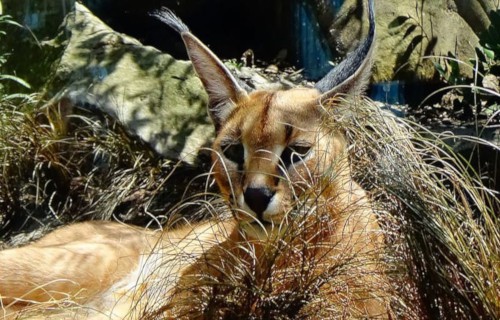
Caracal Physical Description
The truly gorgeous Caracal ranks as a rather medium-sized wild feline and displays no discernible degree of sexual dimorphism.
It also has a rather stocky build, relative to most wild felines. Furthermore, the average height at the shoulder equals about 20 in (50 cm), and maximum weight is 40 lb (18 kg).
In addition, in coloring, individuals most commonly display shades of tan or sandy-red. However, slightly reddish markings appear on various part of the body.
The most visually striking feature, however, remains the strongly tufted ears, strongly resembling many types of lynxes.
- Kingdom: Animalia
- Phylum: Chordata
- Class: Mammalia
- Order: Carnivora
- Family: Felidae
- Genus: Caracal
- Species: C. caracal
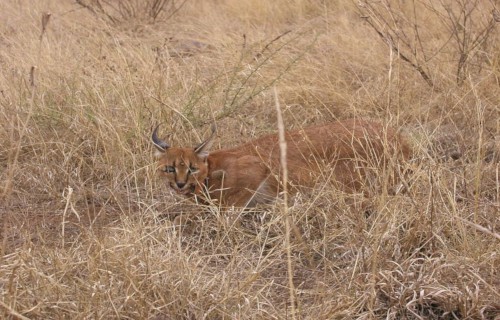
Caracal Distribution, Habitat, and Ecology
The magnificent Caracal actually inhabits an extremely wide range, which includes portions of Africa, the Middle East, and Asia, including India.
It has also proven to be highly adaptable and thrives in habitats that include forest, savannas, marshes, and even semi-desert regions.
Most commonly, it prefers areas with low rainfall and copious cover, yet also inhabits altitudes of up to 9,800 ft (3,000 m).
Like other related species, it also has a carnivorous diet and primarily feeds on birds, rodents, and other smaller mammals.
However, if smaller prey remains absent, individuals have been known to prey on larger animals, such as sheep and goats.
Jaguarundi
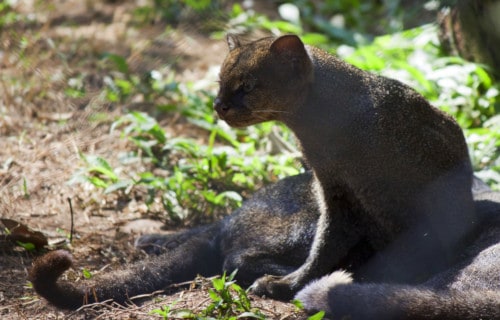
CCL: http://bit.ly/2xQPH8p
Jaguarundi Facts
- Not to be left out of the ranks of Wonderful Wild Cats of the World is the remarkable feline known as the Jaguarundi.
- Theis remarkable mammal is a species that, quite sadly, only shows scattered population groupings. Therefore, it remains vulnerable for several reasons.
- Officials generally fear that these pockets of habitation seem to be dying out, however. It now represents a protected species, but hunting does not pose its greatest threat.
- Most notably, loss of much of its traditional habitat serves as the principal threat to the continued existence of this mammal.
- Finally, the Amazon Basin currently forms the only region in which its numbers appear to be stable.
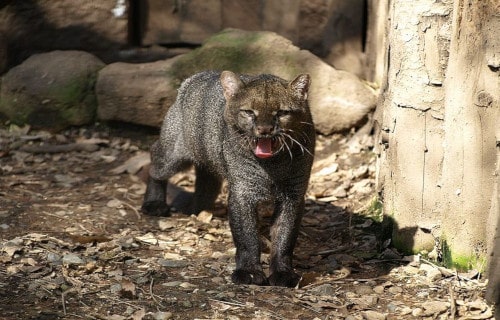
CCL: http://bit.ly/2IjEG4n
Jaguarundi Physical Description
Firstly, the adult Jaguarundi averages roughly 30 in (77 cm) in body length. The tail also reaches about 24 in (60 cm) in length. Further, adults sometimes weigh as much as 20 lb (9.1 kg).
This amazing species displays no noticeable degree of sexual dimorphism, in either appearance or size. Yet it does display one unique trait.
The fur of different individuals sometimes appears as either chestnut or brownish-black in color. But there seems to be no genetic tendency for this, since individuals of either or both patterns may be born in the same litter.
In addition, the Jaguarundi remains known for its distinctively short legs. The body develops elongated, and the tail relatively long. The fur of the animal generally appears uniform in color, with few markings or spots.
- Kingdom: Animalia
- Phylum: Chordata
- Class: Mammalia
- Order: Carnivora
- Family: Felidae
- Genus: Herpailurus
- Species: H. yagouaroundi
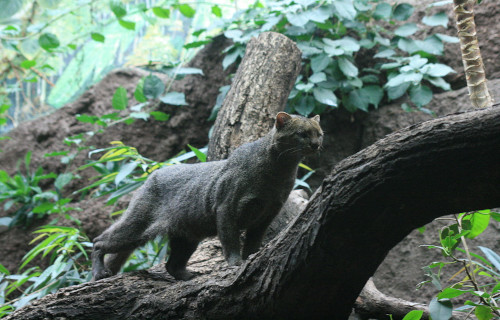
Jaguarundi Distribution, Habitat, and Ecology
The amazing Jaguarundi is a small species of wildcat primarily endemic to regions of South America and Central America. Scattered small populations of this animal still also exist as far north as the states of Texas and Florida, in North America.
Furthermore, this feline prefers to inhabit low-lying areas of the brush in close proximity to streams or small rivers. Such habitats range from wet grasslands to dry forests.
Human encroachment forced it to adapt to some regions, however. Individuals also occur in dense tropical regions, and at altitudes as high as 10,500 ft (3,200 m) on occasion.
Despite the intense activity, some have even been spotted in the vicinity of the Guiana Space Center, in French Guiana.
Geoffroy’s Cat
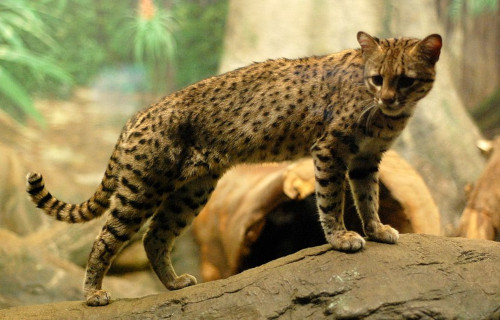
CCL: https://bit.ly/2qv0xkG
Geoffroy’s Cat Facts
- The next of our choices of Wonderful Wild Cats of the World is another that will surprise you, the Geoffroy’s Cat.
- First of all, one important fact must be pointed out about the remarkable feline. Despite the size and appearance of this particular feline, it remains a wild cat, and not a domesticated species.
- Yet another fact sets it apart from many other species of wild feline. That’s the fact that, quite fortunately, the IUCN presently lists it as a Species of Least Concern, on its Red List of Threatened Species.
- This pleasant surprise, in an age when many related species find themselves imperiled, occurs due to a combination of factors. These consist of its comparatively broad range of habitation, and, for the moment, at least, relatively large population base.
- Also, the various local governments in its native range declared the small mammal a protected species in the 1980’s. Previously, it had been extensively hunted as part of the international trade in fur.
- However, it does still face the same potential threats that many other species do at this time. Quite understandably, those consist primarily of the ever-increasing threats of climate change and habitat loss.
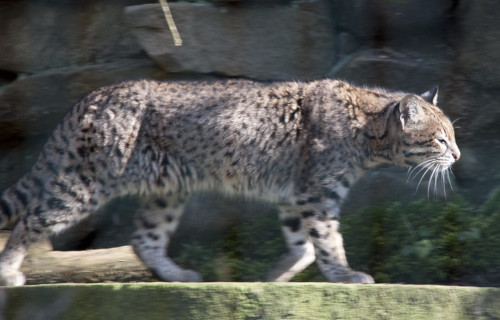
CCL: https://bit.ly/37lxJvO
Geoffroy’s Cat Physical Description
Most notably, the wonderful wild feline known as the Geoffroy’s Cat remains one of the smallest of all wildcats. In addition, the animal does display a moderate degree of sexual dimorphism, like many related creatures.
In its case, though sizes vary between individuals, as a general principle, males attain a slightly larger size than females. However, an average head and body length measures about 24 in (60 cm). The tail usually measures around 12 in (31 cm) in length.
Meanwhile, weights often vary rather significantly among different individuals. But, this typically remains between 44. – 11 lbs (2 – 5 kg). Yet, some exceptional individuals attain a weight of as much as 17 lb (7.8 kg).
In appearance, it generally displays a specific pattern, including a background color ranging from grayish to brownish-yellow. Also, the stomach show a cream color, or even white. But, the limbs, tail, head, cheeks, and neck display many dark bands and spots. Finally, even pure black individuals sometimes occur.
- Kingdom: Animalia
- Phylum: Chordata
- Class: Mammalia
- Order: Carnivora
- Family: Felidae
- Genus: Leopardus
- Species: L. geoffroyi
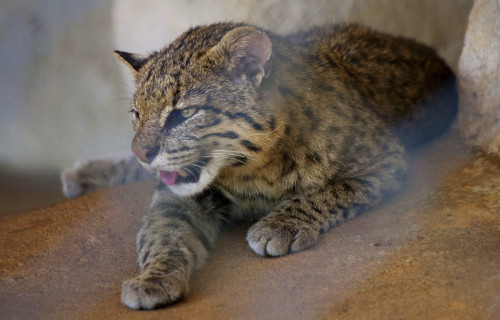
CCL: https://bit.ly/2XqXs1n
Geoffroy’s Cat Distribution, Habitat, and Ecology
Firstly, the relatively extensive range of the wonderful Geoffroy’s Cat includes specific portions of South America. More specifically, this range includes parts of the countries of Bolivia, Chile, Argentina, Brazil, Uruguay, and Paraguay.
The fabulous feline also displays great adaptability in its habitat selection. That’s because it inhabits different types of habitat in different areas. In one portion of that range the wild cat lives in areas of savanna and pampas.
Meanwhile, in another region it resides in areas of grassland and marsh. But, in the Andes, it lives at altitudes of as much as 12,500 ft (3,800 m). There, the animal lives in regions of scrubland or woodlands.
Furthermore, the marvelous Geoffroy’s Cat evolved as a primarily nocturnal species. It also lives a solitary life, except during mating season. Additionally, each individual, of either sex, tends to have its own specific territorial range.
Despite its small stature, the carnivore remains an apex predator within its range. The animal hunts a variety of small game, such as hares, lizards, rodents, frogs, and even on occasion, insects and fish. Although it can climb trees, it rarely does so, preferring to live and hunt on the ground.
Rusty-Spotted Cat
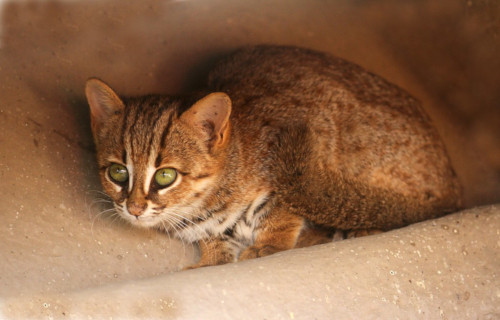
CCL: https://bit.ly/34WWFKR
- Next up on this list of the Wonderful Wild Cats of the World is one of the smallest, the Rusty-Spotted Cat.
- The term for it perfectly serves as the common name for this beautiful wild feline. It’s also far more pronounceable than the scientific name for the animal. That’s because that term’s the tongue-twisting name of Prionailurus rubiginosus.
- It’s held several other scientific names , though. The first scientific recognition, and naming, of the animal occurred in 1831, through the efforts of the French zoologist Isidore Geoffroy Saint-Hilaire. Several other proposed names later followed.
- Whichever name one uses for the magnificent mammal, however certain facts stand out about it. The primary one remains the fact that it’s quite a diminutive member of the cat family. In fact, it currently ranks as one of the smallest of all known wild felines.
- Sadly, like many of the species of the world, the Rusty-Spotted Cat now finds itself in peril. Its population numbers appear to be dwindling rapidly, for various reasons. As a result, the IUCN now lists the mammal as Near Threatened on its Red List.
- For the moment, habit loss appears to be the primary factor behind its decline. This occurs mainly due to its native habit being destroyed as part of cultivation efforts by humans. It also, however, now faces the threat of climate change, like other species.
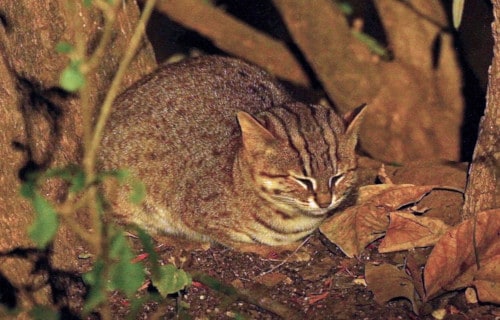
CCL: https://bit.ly/3mRzeIS
Rusty-Spotted Cat Physical Description
The fabulous Rusty-Spotted Cat elegantly proves the principle that beauty comes in all shapes and sizes. That’s because, by any measure, it’s a small species of feline, despite its great appeal. Nature continually demonstrates its apparent love of variety in its creations.
Like many mammals, though, this remarkable variety of wild cat displays the physiological characteristic of sexual dimorphism. It further follows the pattern of the majority of felines in that this trait primarily manifests itself in terms of sheer physical size.
More precisely, the males attain a greater average body weight than the females. That difference, however, remains comparatively minor. A male reaches an average body weight of roughly 3.75 lb (1.7 kg.) The slightly smaller female, meanwhile, averages about 3.1 lb (1.4 kg).
In terms of overall appearance, though, the genders appear essentially indistinguishable. Typically, the fur develops as quite short, and mainly displays a brownish color across most of the body. It further shows a mild rusty tinge, hence the common name.
The animal does, though, present a different pattern on the throat and the underside of the body. There, the fur develops as a light white. It’s also marked with random dark stripes and spots. Typically, individuals also have four dark stripes extending back from over the eyes.
- Kingdom: Animalia
- Phylum: Chordata
- Class: Mammalia
- Order: Carnivora
- Family: Felidae
- Genus: Prionailurus
- Species: P. rubiginosus
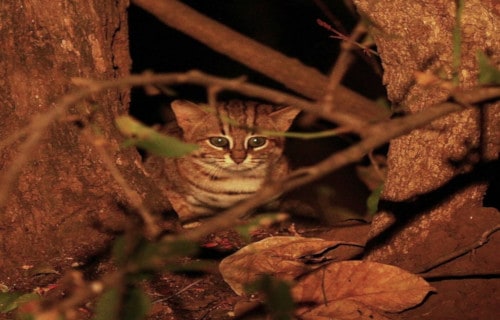
CCL: https://bit.ly/3mOEBIW
Rusty-Spotted cat Distribution, Habitat, and Ecology
Lamentably, the Rusty-Spotted Cat only appears to inhabit a very small portion of the globe. In this instance, that region covers a tiny section of the continent of Asia. More specifically, the only known habitat range of the animal consists of portions of Sri Lanka and India.
Its main habitat remains very specific in nature. The majority of individuals appear in regions of relatively dry forests. In recent years, however, small groups have begun to appear in agricultural areas inhabited by humans. The exact reason for this remains unknown.
Yet its adaptability does not end there. Perhaps in response to human encroachment on its natural territory, groupings now appear to be expanding their range. In fact, a few scattered individuals now inhabit both tropical and semi-arid areas.
Evidence indicates that the Rusty-Spotted Cat evolved as a mainly solitary animal. Most individuals live alone, and usually remain within clearly defined personal territories. Although mainly terrestrial in nature, it also displays tendencies toward arboreal activities.
Like its many related species, this mammal also evolved as carnivorous in nature. Given its size, its prey typically consists of smaller creatures. This largely consists of small birds and other mammals. Yet it also feeds opportunistically, including eating insects such as crickets.
Somewhat surprisingly for researchers, it appears to have no natural predators. It must be pointed out, however, that detailed studies of its habits and life cycle remain few. Most likely, it falls prey to a variety of larger carnivores sharing its native range.
Wonderful Wild Cats of the World

CCL: http://bit.ly/2xLZ0ap
The beauty and majesty of cats…of all sizes…seems to know no bounds. These represent the Wonderful Wild Cats of the World. Sadly, however, many of these majestic creatures face serious threats to their continued existence. We must do more to protect them, for the sake of us all. Let us know what you think of these and other wild felines.
Check out our other articles on 7 Bizarre and Unusual Birds, 7 Truly Breathtaking Mammals, 10 Extraordinary Reptiles









Leave a Reply